MyBatis学习笔记
1、MyBatis
MyBatis 是一款优秀的持久层框架,它支持自定义 SQL、存储过程以及高级映射。
MyBatis 免除了几乎所有的 JDBC 代码以及设置参数和获取结果集的工作。
MyBatis 可以通过简单的 XML 或注解来配置和映射原始类型、接口和 Java POJO(Plain Old Java Objects,普通老式 Java 对象)为数据库中的记录。

MyBatis 本是apache的一个开源项目iBatis, 2010年这个项目由apache software foundation 迁移到了google code,并且改名为MyBatis 。2013年11月迁移到 Github。
1.1、获取MyBatis
- Maven仓库
<!-- https://mvnrepository.com/artifact/org.mybatis/mybatis -->
<dependency>
<groupId>org.mybatis</groupId>
<artifactId>mybatis</artifactId>
<version>3.4.6</version>
</dependency>
1.2、持久化
- 数据持久化就是将程序的数据在持久状态和瞬时状态转化的过程
- 内存:断电即失
- 持久化方式:数据库(JDBC),IO文件持久化
1.3、持久层
Dao层,service层,controller层
- 层是界限明显的
- 完成持久化工作的代码块
1.4、MyBatis优点
- 简化传统的JDBC代码,实现自动化
- 帮助程序员将数据存入数据库
- SQL与代码分离
- 简单易学,灵活
- 提供映射标签,支持对象与数据库ORM映射
2、第一个MyBatis程序
2.1、创建项目
- 创建数据库
-- 创建数据库
CREATE DATABASE `mybatis`;
USE `mybatis`;
-- 如果存在则删除
DROP TABLE IF EXISTS `user`;
-- 创建数据库
CREATE TABLE `user`(
`id` INT(20) NOT NULL PRIMARY KEY,
`name` VARCHAR(30) DEFAULT NULL,
`pwd` VARCHAR(30) DEFAULT NULL
)ENGINE=INNODB DEFAULT CHARSET=utf8;
-- 插入数据
INSERT INTO `user`(`id`,`name`,`pwd`) VALUES (1,'狂神','123456'),(2,'张三','abcdef'),(3,'李四','987654');`mybatis`
-
创建普通Maven项目,删除src目录使其充当父工程
-
导入依赖
<dependency>
<groupId>mysql</groupId>
<artifactId>mysql-connector-java</artifactId>
<version>5.1.47</version>
</dependency>
<dependency>
<groupId>org.mybatis</groupId>
<artifactId>mybatis</artifactId>
<version>3.5.2</version>
</dependency>
<dependency>
<groupId>junit</groupId>
<artifactId>junit</artifactId>
<version>4.12</version>
</dependency>
- 在父工程中创建一个子模块
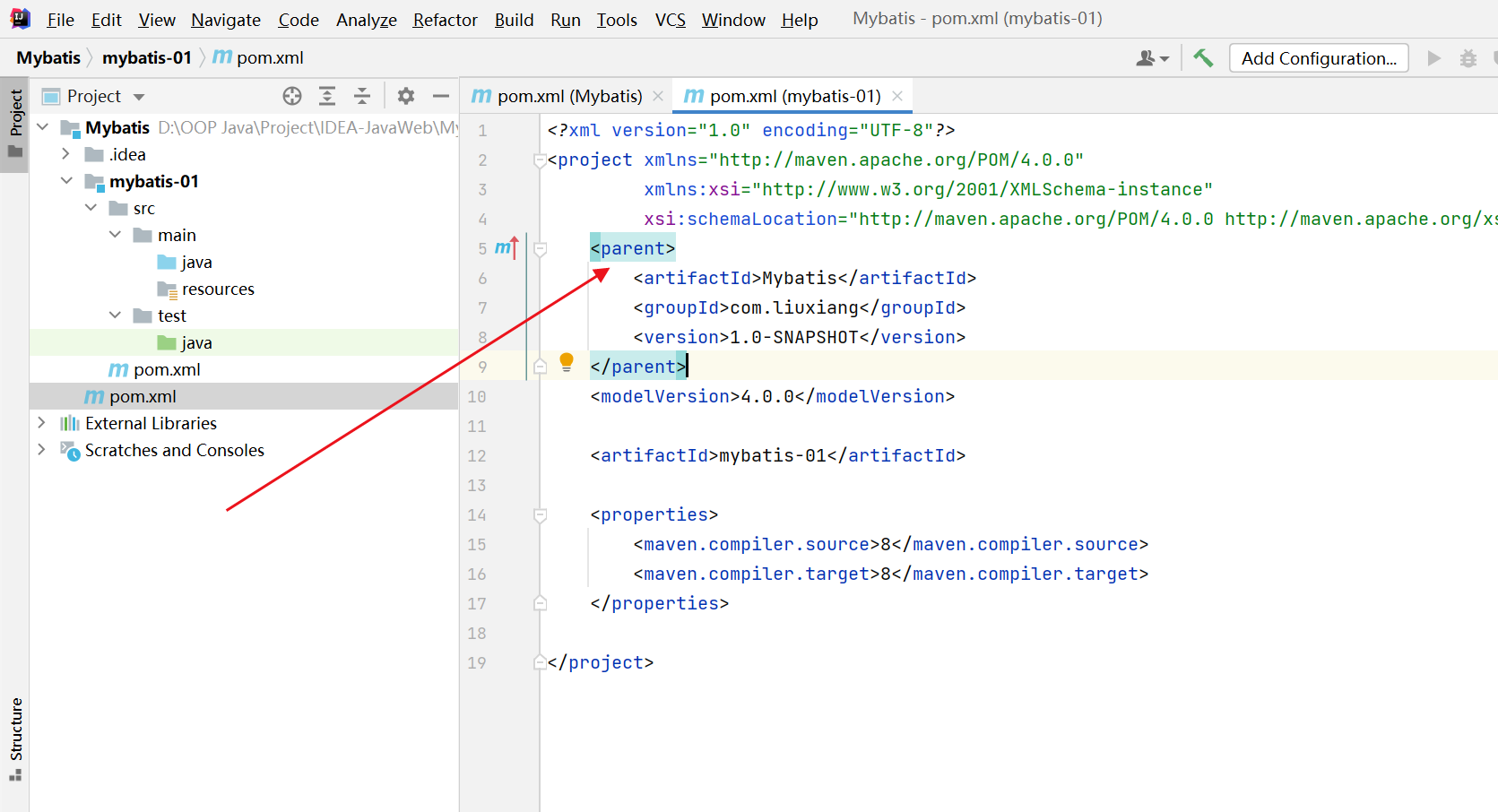
2.2、编写核心配置文件
- 创建
mybatis-config.xml配置文件
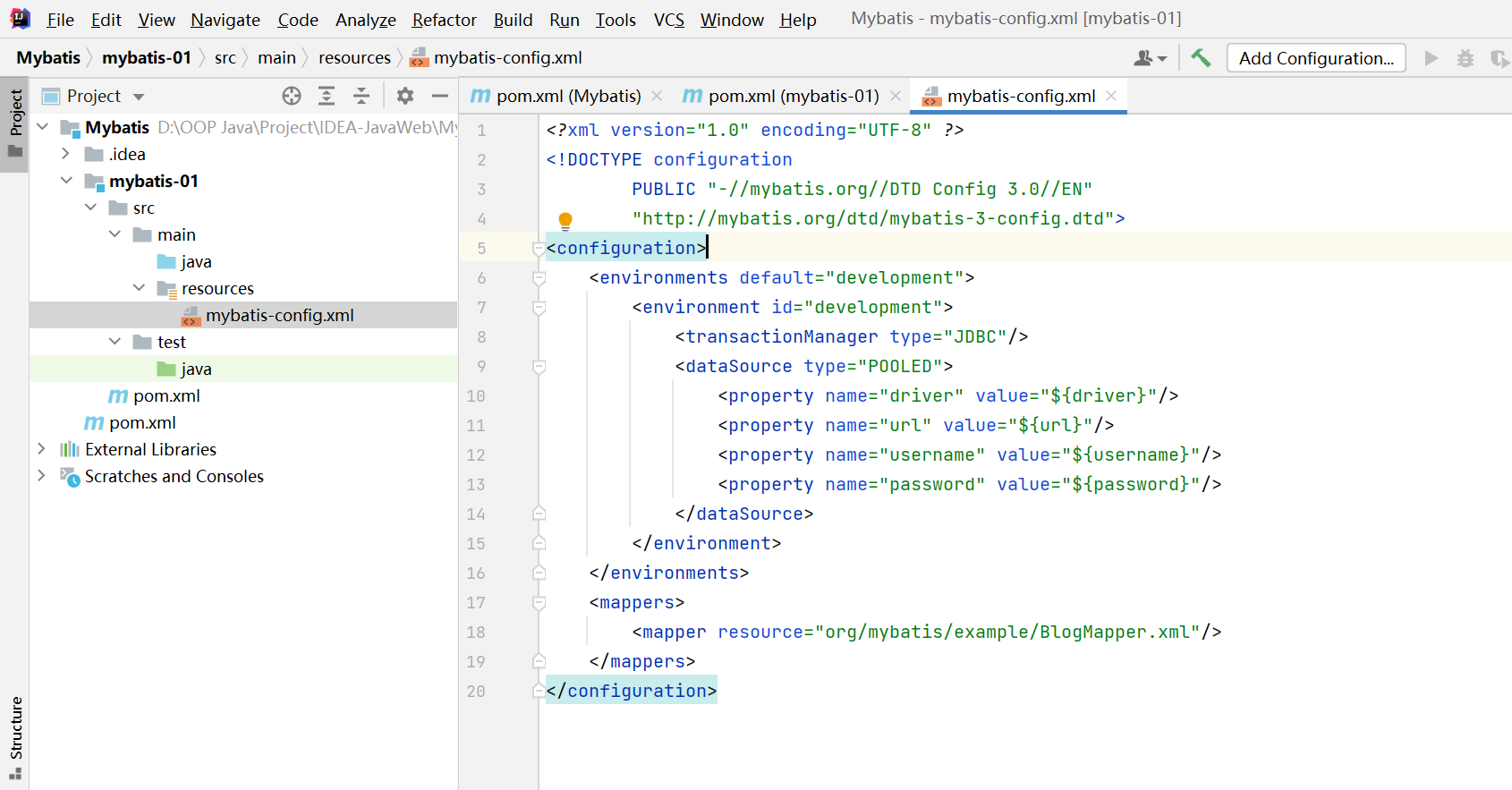
xml文件中最好不要中文注释
<?xml version="1.0" encoding="UTF-8" ?>
<!DOCTYPE configuration
PUBLIC "-//mybatis.org//DTD Config 3.0//EN"
"http://mybatis.org/dtd/mybatis-3-config.dtd">
<configuration>
<environments default="development">
<environment id="development">
<transactionManager type="JDBC"/>
<dataSource type="POOLED">
<property name="driver" value="com.mysql.jdbc.Driver"/>
<property name="url" value="jdbc:mysql://localhost:3306/mybatis?serverTimezone=UTC&useUnicode=true&characterEncoding=utf8&useSSL=true"/>
<property name="username" value="root"/>
<property name="password" value="123456"/>
</dataSource>
</environment>
</environments>
</configuration>
<!--mybatis-config.xml配置文件解析-->
<?xml version="1.0" encoding="UTF-8" ?>
<!DOCTYPE configuration
PUBLIC "-//mybatis.org//DTD Config 3.0//EN"
"http://mybatis.org/dtd/mybatis-3-config.dtd">
<!--核心配置文件-->
<configuration>
<!--环境environments 在内配置多套环境 default指定默认环境-->
<environments default="development">
<environment id="development">
<transactionManager type="JDBC"/><!--事务管理 默认使用JDBC事务管理-->
<dataSource type="POOLED">
<!--配置数据源-->
<property name="driver" value="com.mysql.jdbc.Driver"/>
<!--配置数据库连接 数据库密码-->
<property name="url" value="jdbc:mysql://localhost:3306/mybatis?serverTimezone=UTC&useUnicode=true&characterEncoding=utf8&useSSL=true"/>
<property name="username" value="root"/>
<property name="password" value="123456"/>
</dataSource>
</environment>
</environments>
</configuration>
2.3、编写Mybatis工具类
- 阅读官方文档


从SqlSessionFactory中获取到SqlSession,就可以执行其中的SQL语句SqlSession相当于JDBC中的statement。
- 创建utils目录,创建MybatisUtils工具类
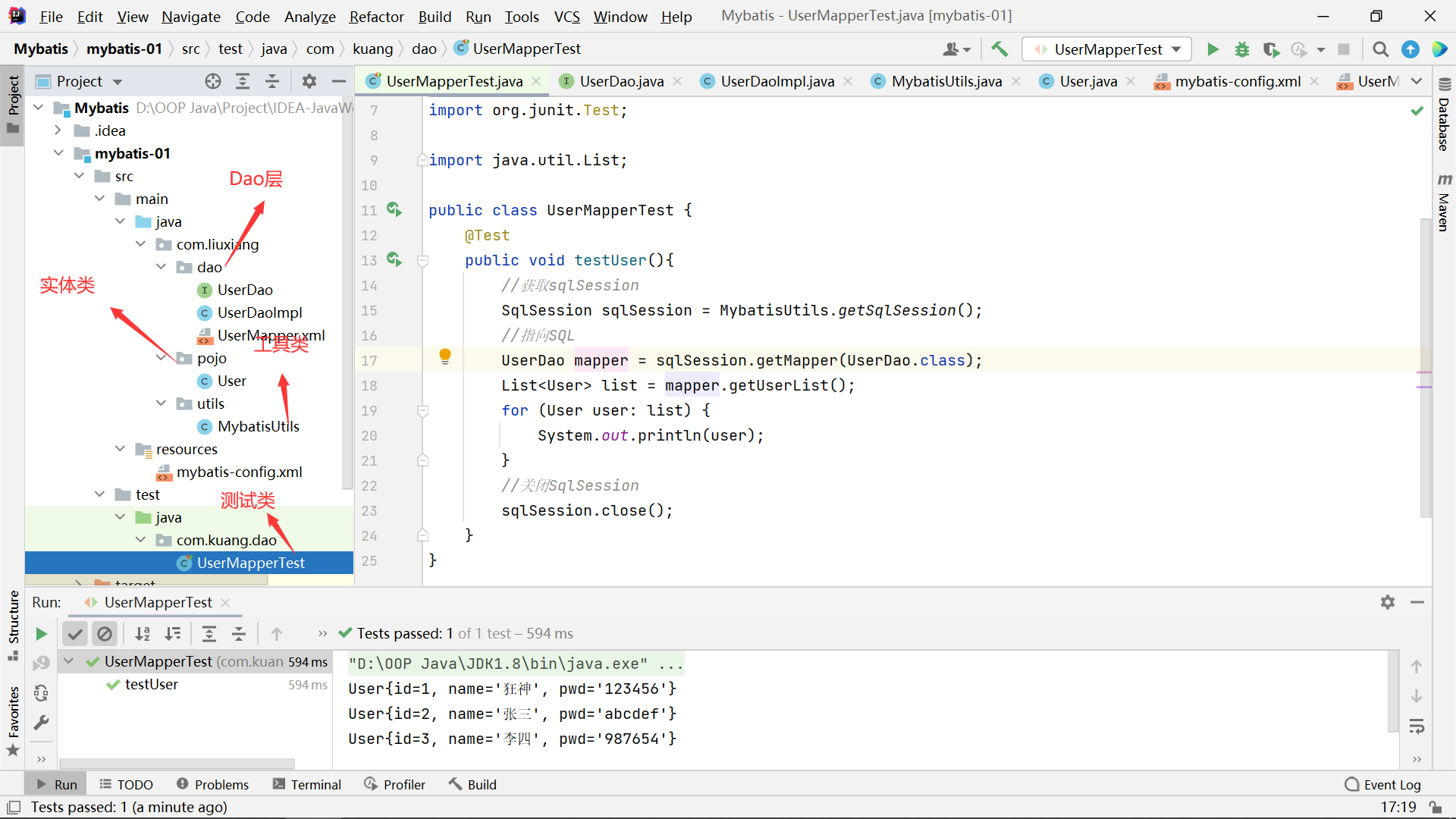
package com.liuxiang.utils;
import org.apache.ibatis.io.Resources;
import org.apache.ibatis.session.SqlSession;
import org.apache.ibatis.session.SqlSessionFactory;
import org.apache.ibatis.session.SqlSessionFactoryBuilder;
import java.io.IOException;
import java.io.InputStream;
public class MybatisUtils {
private static SqlSessionFactory sqlSessionFactory=null;
//从官方文档取出的代码 获取SqlSessionFactory
static{
String resource = "mybatis-config.xml";
InputStream inputStream = null;
try {
inputStream = Resources.getResourceAsStream(resource);
sqlSessionFactory = new SqlSessionFactoryBuilder().build(inputStream);
} catch (IOException e) {
e.printStackTrace();
}
}
/**
* 获取SqlSession
*
* 既然有了 SqlSessionFactory,顾名思义,
* 我们可以从中获得 SqlSession 的实例。SqlSession 提供了在数据库执行 SQL 命令所需的所有方法。
* 你可以通过 SqlSession 实例来直接执行已映射的 SQL 语句
* @return
*/
public static SqlSession getSqlSession(){
return sqlSessionFactory.openSession();
}
}
- 编写实体类
package com.liuxiang.pojo;
public class User {
private int id;
private String name;
private String pwd;
public User() {
}
public User(int id, String name, String pwd) {
this.id = id;
this.name = name;
this.pwd = pwd;
}
public int getId() {
return id;
}
public void setId(int id) {
this.id = id;
}
public String getName() {
return name;
}
public void setName(String name) {
this.name = name;
}
public String getPwd() {
return pwd;
}
public void setPwd(String pwd) {
this.pwd = pwd;
}
@Override
public String toString() {
return "User{" +
"id=" + id +
", name='" + name + '\'' +
", pwd='" + pwd + '\'' +
'}';
}
}
- 编写UserDao接口(与UserMapper一个意思)及其实现类
package com.liuxiang.dao;
import com.liuxiang.pojo.User;
import java.util.List;
public interface UserDao {
public List<User> getUserList();
}
package com.liuxiang.dao;
import com.liuxiang.pojo.User;
import java.util.List;
public class UserDaoImpl implements UserDao{
@Override
public List<User> getUserList() {
// 编写jdbc代码
return null;
}
}
从官方文档可以看出,MyBatis几乎避免了几乎所有JDBC代码,由原来的接口实现类变成xml文件。
所以这里我们不用编写接口实现类,直接创建UserMapper.xml配置文件
- 创建
UserMapper.xml配置文件
<?xml version="1.0" encoding="UTF-8" ?>
<!DOCTYPE mapper
PUBLIC "-//mybatis.org//DTD Mapper 3.0//EN"
"http://mybatis.org/dtd/mybatis-3-mapper.dtd">
<mapper namespace="com.liuxiang.dao.UserDao">
<select id="getUserList" resultType="com.liuxiang.pojo.User">
select * from user
</select>
</mapper>
<!--UserMapper.xml配置文件解析-->
<?xml version="1.0" encoding="UTF-8" ?>
<!DOCTYPE mapper
PUBLIC "-//mybatis.org//DTD Mapper 3.0//EN"
"http://mybatis.org/dtd/mybatis-3-mapper.dtd">
<!--namespace 命名空间 指向 定义一个Dao接口-->
<mapper namespace="com.liuxiang.dao.UserDao"><!--定义接口全路径名-->
<!--查询语句select id指向接口中的方法名 resultType指向查询结果集封装-->
<select id="getUserList" resultType="com.liuxiang.pojo.User">
select * from user
</select>
</mapper>
2.4、测试程序
- 编写Test测试文件
编写 Junit 测试文件来测试UserMapper.xml
package com.kuang.dao;
import com.liuxiang.dao.UserDao;
import com.liuxiang.pojo.User;
import com.liuxiang.utils.MybatisUtils;
import org.apache.ibatis.session.SqlSession;
import org.junit.Test;
import java.util.List;
public class UserMapperTest {
@Test
public void testUser(){
//获取sqlSession
SqlSession sqlSession = MybatisUtils.getSqlSession();
//指向SQL
UserDao mapper = sqlSession.getMapper(UserDao.class);
List<User> list = mapper.getUserList();
for (User user: list) {
System.out.println(user);
}
//关闭SqlSession
sqlSession.close();
}
}
- 排错
- 报 org.apache.ibatis.binding.BindingException: Type interface com.liuxiang.dao.UserDao is not known to the MapperRegistry. 错误,原因是核心配置文件中缺少指向UserMapper.xml的配置。
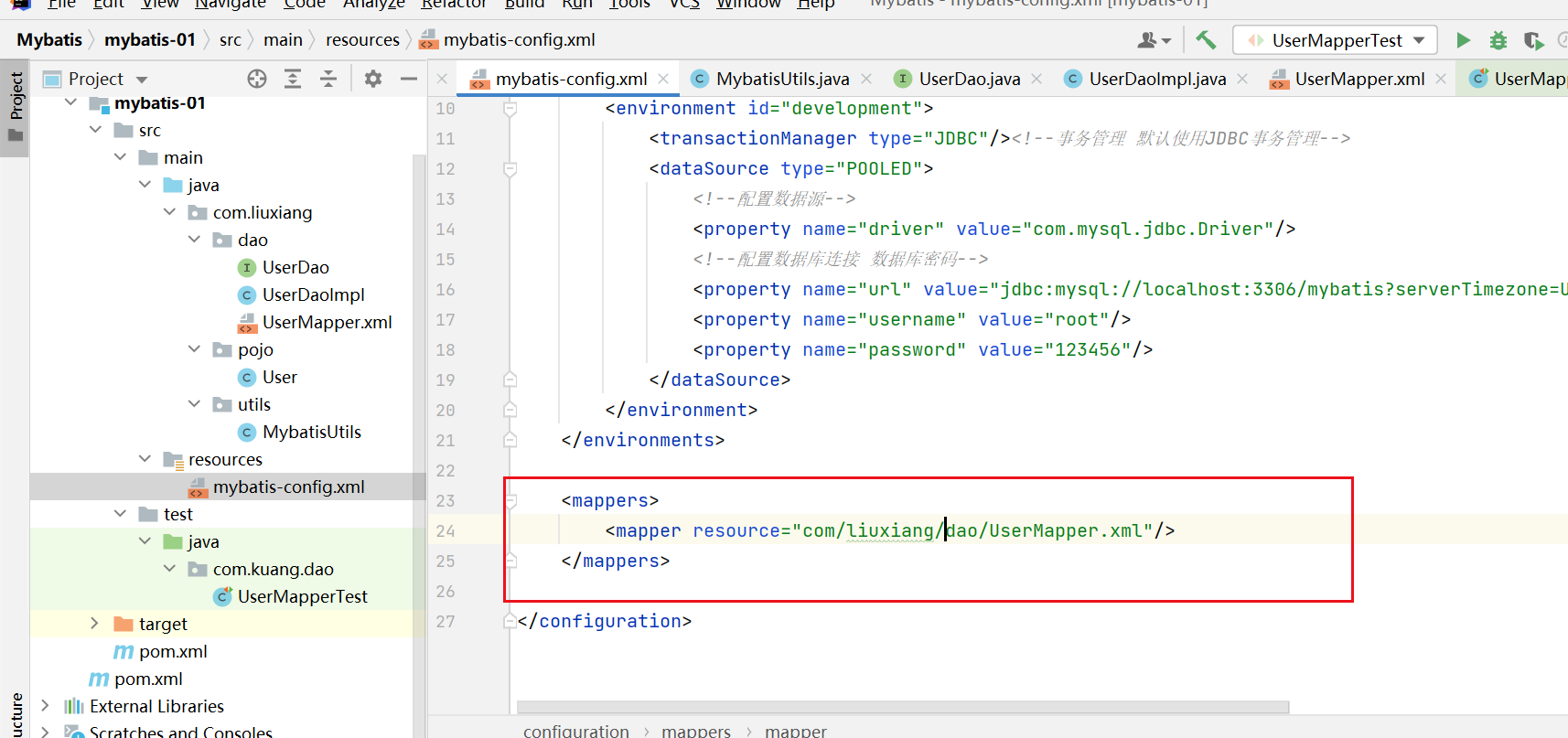
<mappers>
<mapper resource="com/liuxiang/dao/UserMapper.xml"/>
</mappers>
- 报 Error parsing SQL Mapper Configuration. Cause: java.io.IOException: Could not find resource com/liuxiang/dao/UserMapper.xml 错误,无法找到 UserMapper.xml 文件,这是Maven过滤的问题的原因 无法导出配置文件。
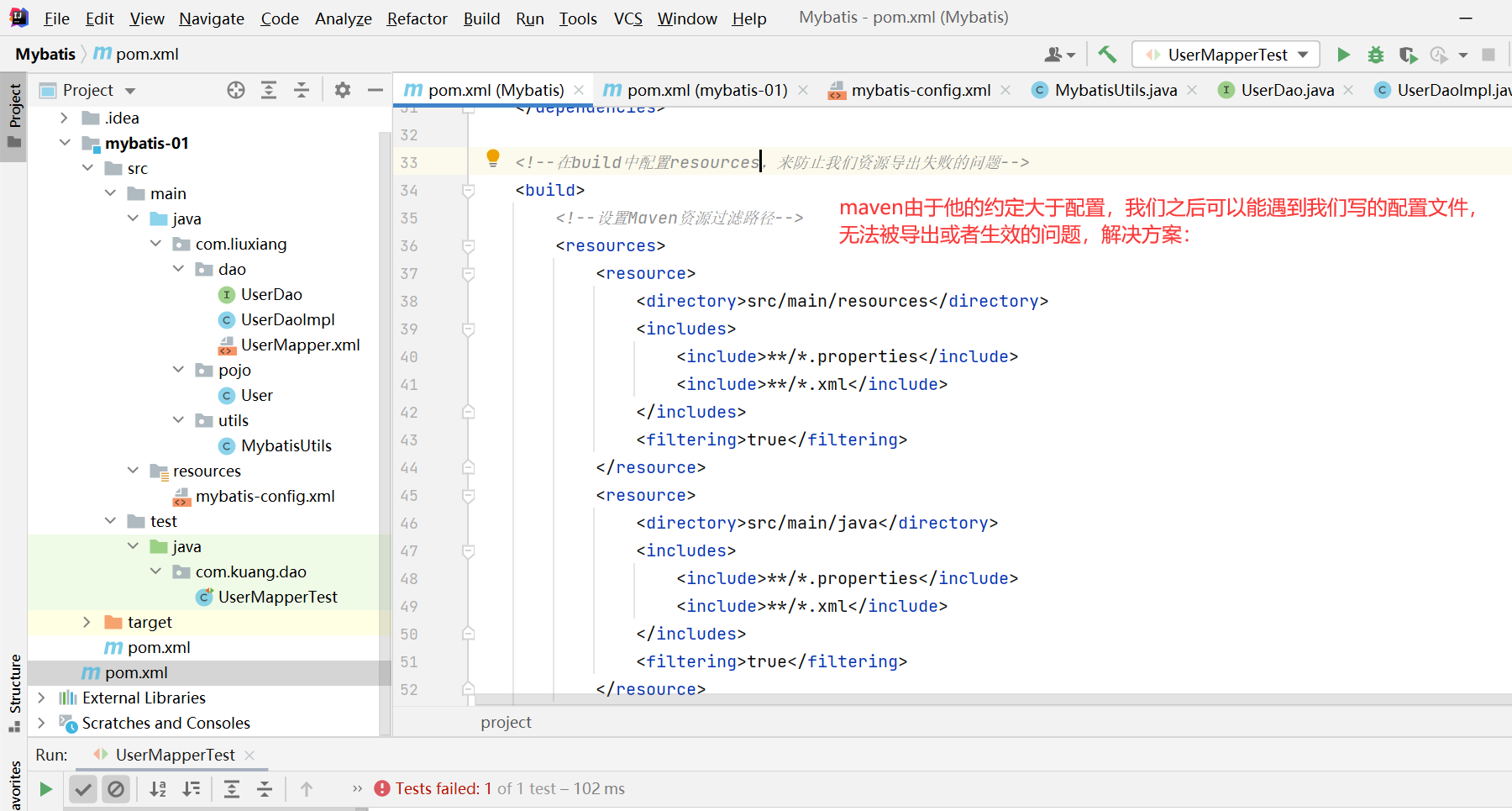
<!--在build中配置resources,来防止我们资源导出失败的问题-->
<build>
<!--设置Maven资源过滤路径-->
<resources>
<resource>
<directory>src/main/resources</directory>
<includes>
<include>**/*.properties</include>
<include>**/*.xml</include>
</includes>
<filtering>true</filtering>
</resource>
<resource>
<directory>src/main/java</directory>
<includes>
<include>**/*.properties</include>
<include>**/*.xml</include>
</includes>
<filtering>true</filtering>
</resource>
</resources>
</build>
- 报 Caused by: org.apache.ibatis.builder.BuilderException: Error creating document instance. Cause: org.xml.sax.SAXParseException; lineNumber: 18; columnNumber: 11; 2 字节的 UTF-8 序列的字节 2 无效的错误,只需要把 mybatis-config.xml 与 UserMapper.xml 文件中的中文注释删除掉,或者修改xml文件中的
UTF-8为UTF8。
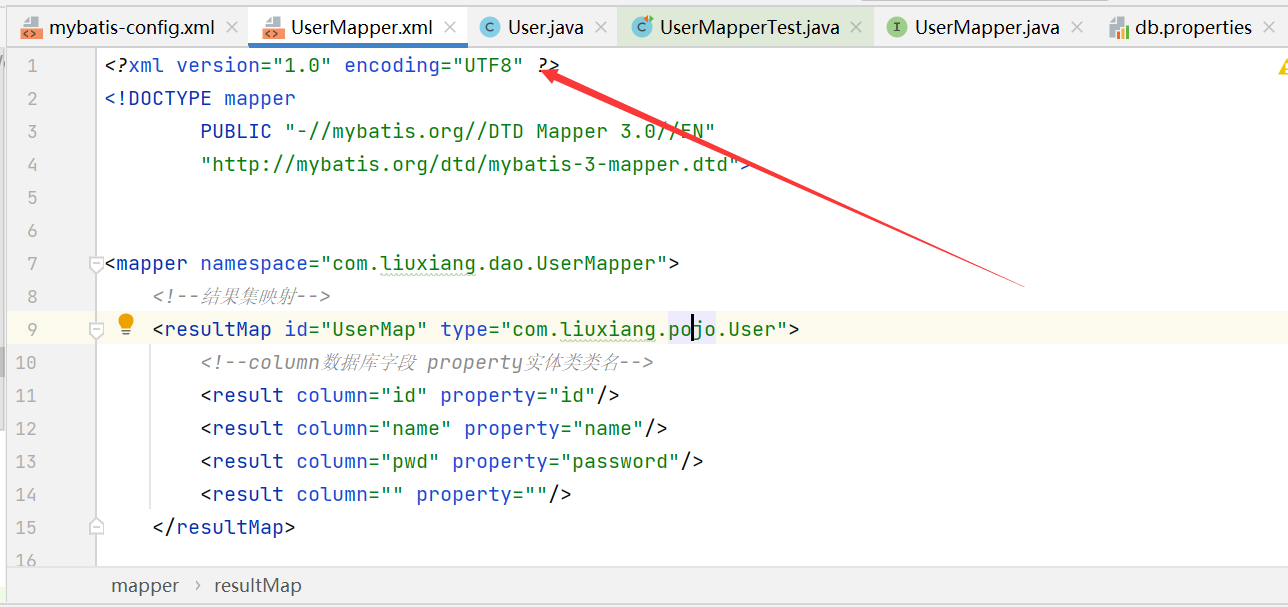
- 测试成功
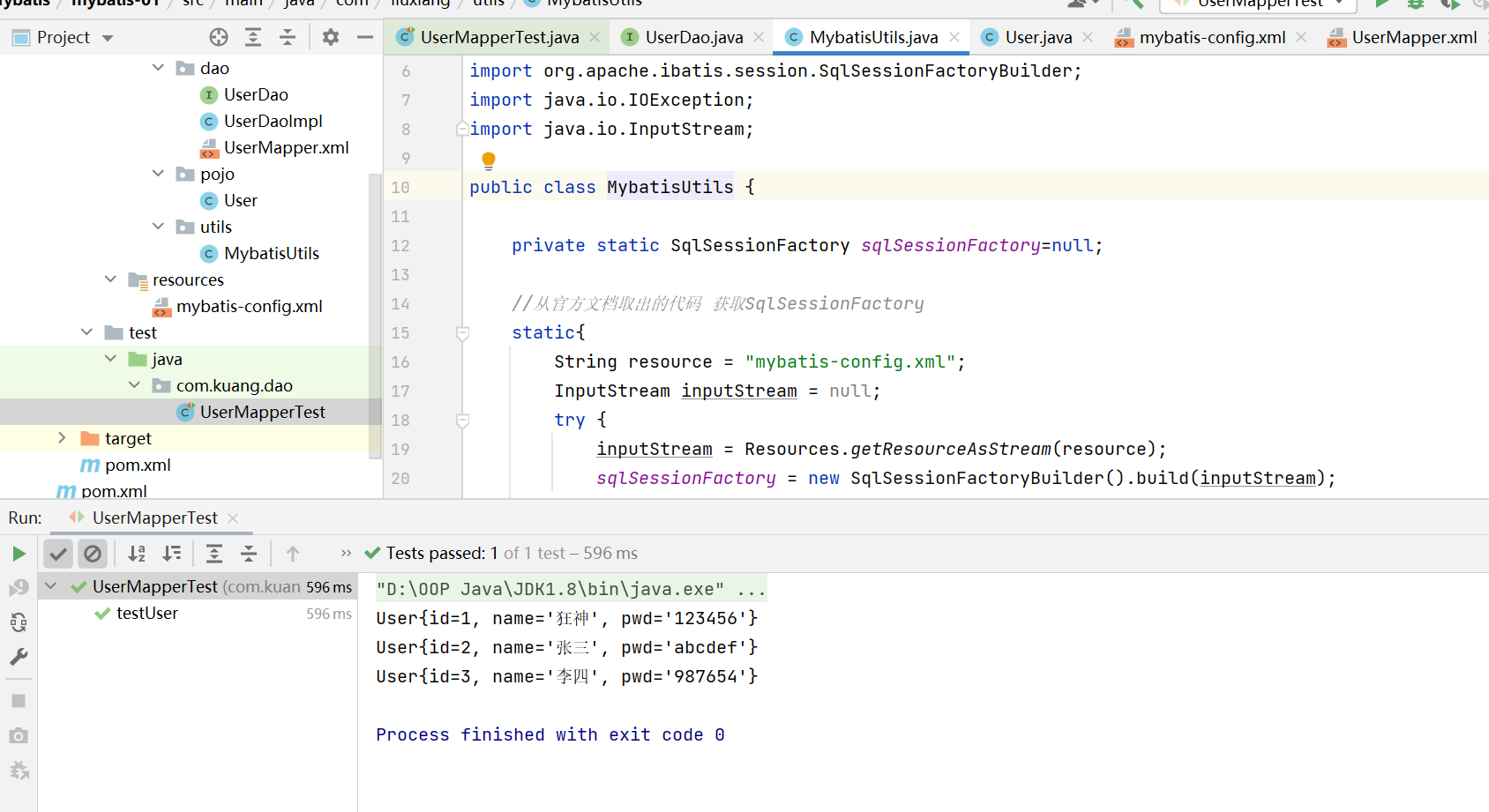
2.5、作用域与生命周期
作用域和生命周期类别是至关重要的,因为错误的使用会导致非常严重的并发问题
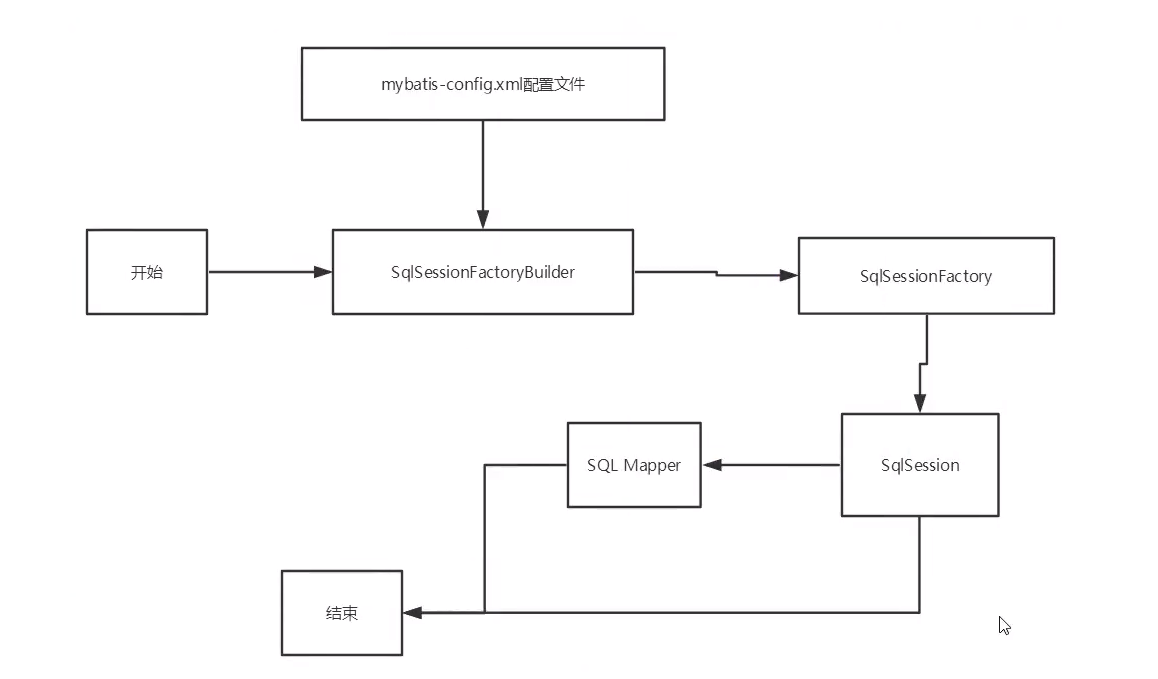
- SqlSessionFactoryBuilder
这个类可以被实例化、使用和丢弃,一旦创建了 SqlSessionFactory,就不再需要它了。因此 SqlSessionFactoryBuilder 实例的最佳作用域是方法作用域(也就是局部方法变量)。 你可以重用 SqlSessionFactoryBuilder 来创建多个 SqlSessionFactory 实例,但最好还是不要一直保留着它,以保证所有的 XML 解析资源可以被释放给更重要的事情。
- SqlSessionFactory
可以把它想象成数据库连接池
SqlSessionFactory 一旦被创建就应该在应用的运行期间一直存在,没有任何理由丢弃它或重新创建另一个实例。 使用 SqlSessionFactory 的最佳实践是在应用运行期间不要重复创建多次,多次重建 SqlSessionFactory 被视为一种代码“坏习惯”。因此 SqlSessionFactory 的最佳作用域是应用作用域。 有很多方法可以做到,最简单的就是使用单例模式或者静态单例模式。
- SqlSession
每个线程都应该有它自己的 SqlSession 实例。SqlSession 的实例不是线程安全的,因此是不能被共享的,所以它的最佳的作用域是请求或方法作用域。 绝对不能将 SqlSession 实例的引用放在一个类的静态域,甚至一个类的实例变量也不行。 也绝不能将 SqlSession 实例的引用放在任何类型的托管作用域中,比如 Servlet 框架中的 HttpSession。 如果你现在正在使用一种 Web 框架,考虑将 SqlSession 放在一个和 HTTP 请求相似的作用域中。 换句话说,每次收到 HTTP 请求,就可以打开一个 SqlSession,返回一个响应后,就关闭它。 这个关闭操作很重要,为了确保每次都能执行关闭操作,你应该把这个关闭操作放到 finally 块中。
在所有代码中都遵循这种使用模式,可以保证所有数据库资源都能被正确地关闭。
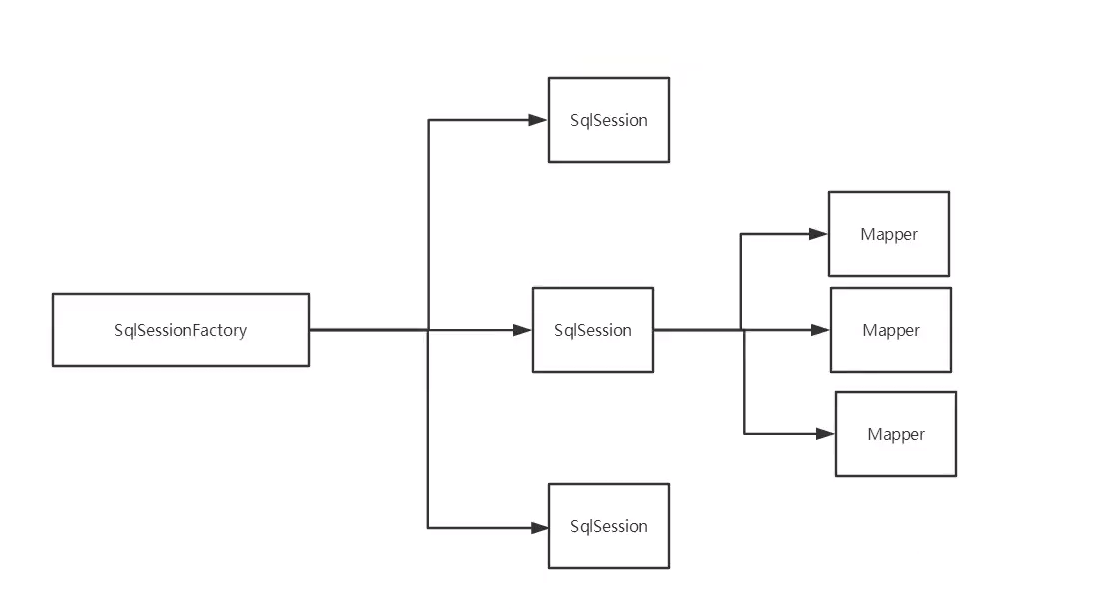
- SqlSession调用方式

2.6、MyBatis执行流程

3、CRUD
3.1、查询
- 更改
UserDao接口名字为UserMapper,在UserMapper接口中新增方法
//指定id查询
public User getUser(int id);
- 在
UserMapper.xml中新增SQL映射,其中 parameterType 是入参类型
<select id="getUser" resultType="com.liuxiang.pojo.User" parameterType="int">
select * from user where id=#{id}
</select>
- 编辑测试类
@Test
public void testupdateMapUser(){
//获取sqlSession
SqlSession sqlSession = MybatisUtils.getSqlSession();
UserMapper mapper = sqlSession.getMapper(UserMapper.class);
User user = mapper.getUser(2);
System.out.println(user);
//关闭SqlSession
sqlSession.close();
}
3.2、增加
- 在
UserMapper接口中新增方法
//新增用户
public int insertUser(User user);
- 在
UserMapper.xml中新增SQL映射
<insert id="insertUser" parameterType="com.liuxiang.pojo.User" >
insert into user (id,name,pwd) values (#{id},#{name},#{pwd})
</insert>
- 编辑测试类
@Test
public void TestinsertUser(){
//获取sqlSession
SqlSession sqlSession = MybatisUtils.getSqlSession();
UserMapper mapper = sqlSession.getMapper(UserMapper.class);
int i = mapper.insertUser(new User(4, "狂神", "123456"));
System.out.println(i);
//关闭SqlSession
sqlSession.close();
}
- 由于增删改必须要提交事务,所以虽然运行成功了,但是实际数据库并没有新增一行数据,因此再次修改测试代码
//增删改必须要提交事务
@Test
public void TestinsertUser(){
//获取sqlSession
SqlSession sqlSession = MybatisUtils.getSqlSession();
UserMapper mapper = sqlSession.getMapper(UserMapper.class);
int i = mapper.insertUser(new User(4, "狂神", "123456"));
System.out.println(i);
//提交事务
sqlSession.commit();
//关闭SqlSession
sqlSession.close();
}

3.3、修改
- 在
UserMapper接口中新增方法
//修改用户
public int UpdateUser(User user);
- 在
UserMapper.xml中新增SQL映射
<update id="UpdateUser" parameterType="com.liuxiang.pojo.User">
update user set name=#{name},pwd=#{pwd} where id=#{id}
</update>
- 编辑测试类
@Test
public void updateUser(){
//获取sqlSession
SqlSession sqlSession = MybatisUtils.getSqlSession();
UserMapper mapper = sqlSession.getMapper(UserMapper.class);
int i = mapper.UpdateUser(new User(1, "狂神", "123456"));
System.out.println(i);
//提交事务
sqlSession.commit();
//关闭SqlSession
sqlSession.close();
}
3.4、删除
- 在
UserMapper接口中新增方法
//删除用户
public int deleteUser(int id);
- 在
UserMapper.xml中新增SQL映射
<delete id="deleteUser" parameterType="int">
delete from user where id=#{id} ;
</delete>
- 编辑测试类
@Test
public void testdeleteUser(){
//获取sqlSession
SqlSession sqlSession = MybatisUtils.getSqlSession();
UserMapper mapper = sqlSession.getMapper(UserMapper.class);
int i = mapper.deleteUser(4);
System.out.println(i);
//提交事务
sqlSession.commit();
//关闭SqlSession
sqlSession.close();
}
3.5、模糊查询
- 在
UserMapper接口中新增方法
//模糊查询
public List<User> getUserLike();
- 在
UserMapper.xml中新增SQL映射
<select id="getUserLike" resultType="com.liuxiang.pojo.User" parameterType="String">
select * from user where name like #{value}
</select>
- 编辑测试类
@Test
public void getUserLike(){
//获取sqlSession
SqlSession sqlSession = MybatisUtils.getSqlSession();
UserMapper mapper = sqlSession.getMapper(UserMapper.class);
List<User> userLike = mapper.getUserLike("%李%");
for (User user:userLike) {
System.out.println(user);
}
//提交事务
sqlSession.commit();
//关闭SqlSession
sqlSession.close();
}
3.6、Map的使用
在实际工作中,如果实体类或数据库字段过多,使用对象 User 的入参方式过于繁琐且每个字段必须得赋值。此时我们可以使用Map来做参数的传递:
- 在
UserMapper接口中新增map修改方法
//修改用户map
public int updateMapUser(Map<String,Object> map);
- 在
UserMapper.xml中新增SQL映射,#{}内的名字可以任意定义,只需要与map中的K保持一致即可
<update id="updateMapUser" parameterType="map">
update user set name=#{nameMap} where id=#{idMap}
</update>
- 编辑测试类
@Test
public void testupdateMapUser(){
//获取sqlSession
SqlSession sqlSession = MybatisUtils.getSqlSession();
UserMapper mapper = sqlSession.getMapper(UserMapper.class);
Map<String, Object> map = new HashMap<String, Object>();
map.put("nameMap","刘翔");
map.put("idMap",2);
int i = mapper.updateMapUser(map);
System.out.println(i);
//提交事务
sqlSession.commit();
//关闭SqlSession
sqlSession.close();
}
map传递参数,直接在SQL中取Key即可,parameterType="map"。
对象传递参数,直接取对象的属性即可,parameterType="Object"。
如果只有单个基本类型参数,parameterType 可以不写。
多个参数用Map,或者注解!
3.7、Limit实现分页查询
分页查询的作用在于减少数据处理量
- 在
UserMapper接口中新增方法
//分页查询
public List<User> limitgetUser(Map<String,Integer> map);
- 在
UserMapper.xml中新增SQL映射
<select id="limitgetUser" parameterType="map" resultType="com.liuxiang.pojo.User">
select * from user limit #{stateInt},#{pageInt}
</select>
- 编写测试类
@Test
public void testlimitgetUser(){
//注意导包:org.apache.log4j.Logger
Logger logger = Logger.getLogger(Log4jTest.class);
//获取sqlSession
SqlSession sqlSession = MybatisUtils.getSqlSession();
UserMapper mapper = sqlSession.getMapper(UserMapper.class);
Map<String, Integer> map = new HashMap<String, Integer>();
map.put("stateInt",0);
map.put("pageInt",2);
List<User> list = mapper.limitgetUser(map);
for (User user : list) {
logger.info("查询结果:"+user);
}
//关闭SqlSession
sqlSession.close();
}
除了使用 Limit 实现分页(SQL),还可以使用 RowBounds 实现分页(Java实现),和分页插件。
3.8、设置自动提交事务
每次都要手动提交事务,相对麻烦
查看SqlSessionFactory源码可知,其中openSession(),可以设置是否自动提交事务。
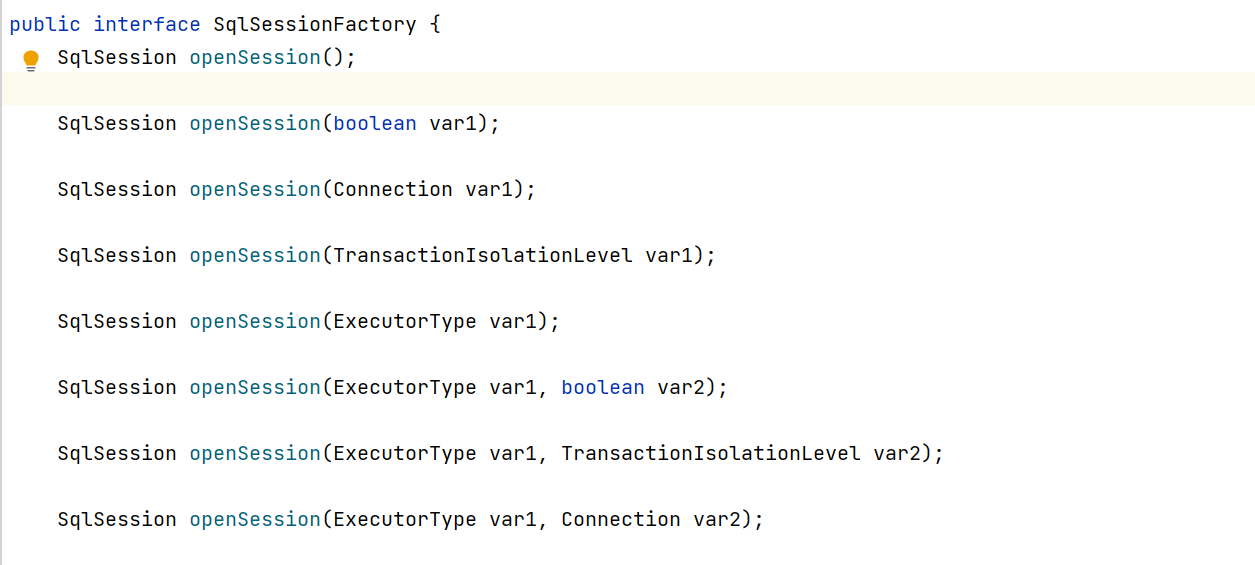
- 修改MybatisUtil工具类
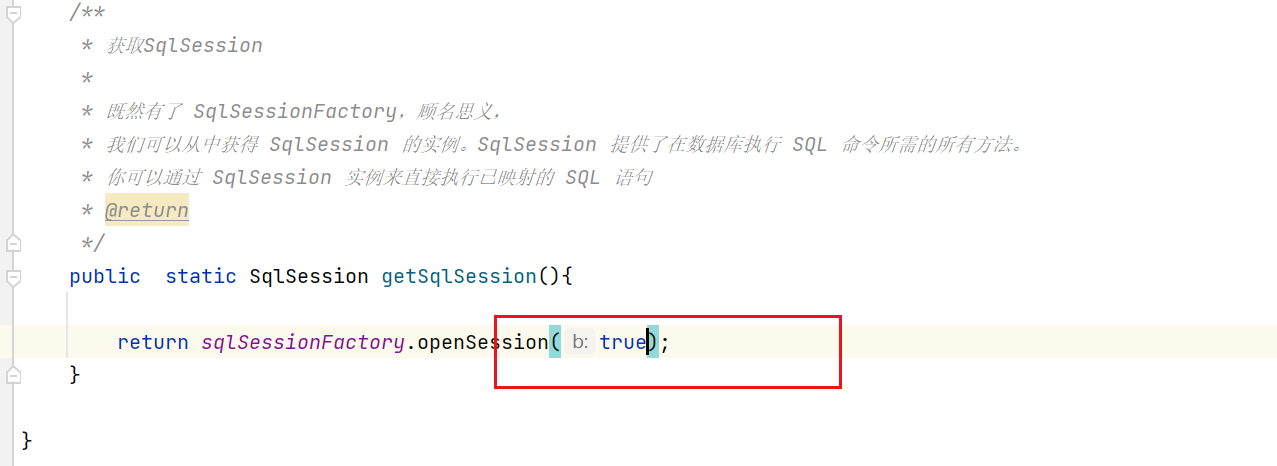
4、配置解析
4.1、核心配置文件
- mybatis-config.xml
![]()
4.2、环境配置(environments)
-
MyBatis 可以配置成适应多种环境
-
不过要记住:尽管可以配置多个环境,但每个 SqlSessionFactory 实例只能选择一种环境。
-
学会配置多套运行环境
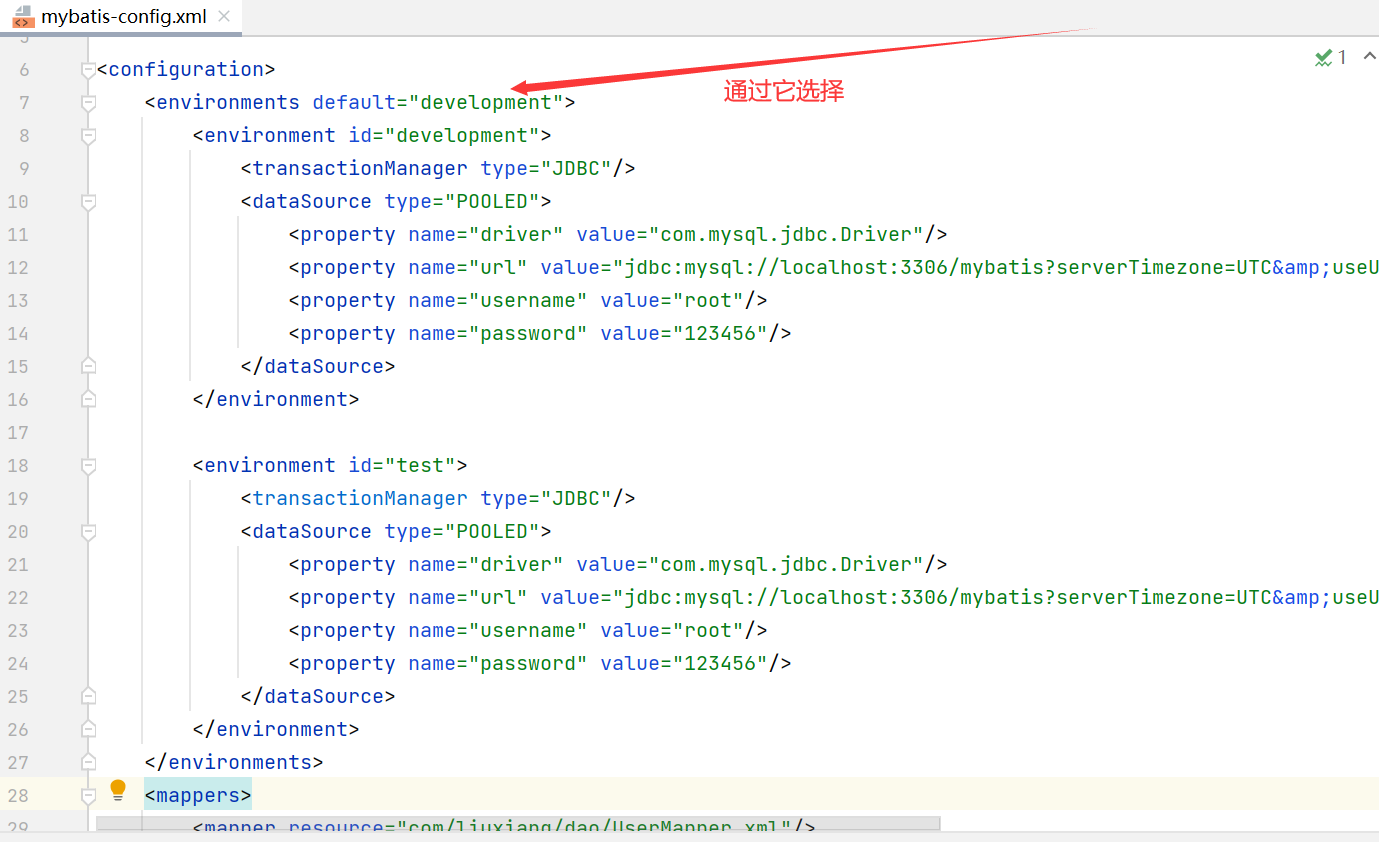
通过default指定默认使用环境
4.3、事务管理器(transactionManager)
在 MyBatis 中有两种类型的事务管理器(也就是 type="[JDBC|MANAGED]"):
- JDBC – 这个配置直接使用了JDBC 的提交和回滚设施,它依赖从数据源获得的连接来管理事务作用
- MANAGED – 这个配置几乎没做什么。它从不提交或回滚一个连接,而是让容器来管理事务的整个生命周期(比如 JEE 应用服务器的上下文)。 默认情况下它会关闭连接。然而一些容器并不希望连接被关闭,因此需要将 closeConnection 属性设置为 false 来阻止默认的关闭行为。
4.4、数据源(dataSource)
配置数据源来连接数据库
dataSource 元素使用标准的 JDBC 数据源接口来配置 JDBC 连接对象的资源。
有三种内建的数据源类型(也就是 type="[UNPOOLED|POOLED|JNDI]"):
-
UNPOOLED– 这个数据源的实现会 每次请求时打开和关闭连接。虽然有点慢, 但对那些数据库连接可用性要求不高的简单应用程序来说,是一个很好的选择。 性能表现则依赖于使用的数据库,对某些数据库来说,使用连接池并不重要,这个配置就很适合这种情形。
-
POOLED– 这种数据源的 实现利用“池”的概念将 JDBC 连接对象组织起来,避免了创建新的连接实例时所必需的初始化和认证时间。 这种处理方式很流行,能使并发 Web 应用快速响应请求。默认使用
-
JNDI – 这个数据源实现是为了能在如 EJB 或应用服务器这类容器中使用,容器可以集中或在外部配置数据源,然后放置一个 JNDI 上下文的数据源引用。
4.5、属性(properties)
我们可以通过 properties 属性来引用配置文件
这些属性可以在外部进行配置,并可以进行动态替换。你既可以在典型的 Java 属性文件中配置这些属性,也可以在 properties 元素的子元素中设置。

- 在resources目录下创建db.properties
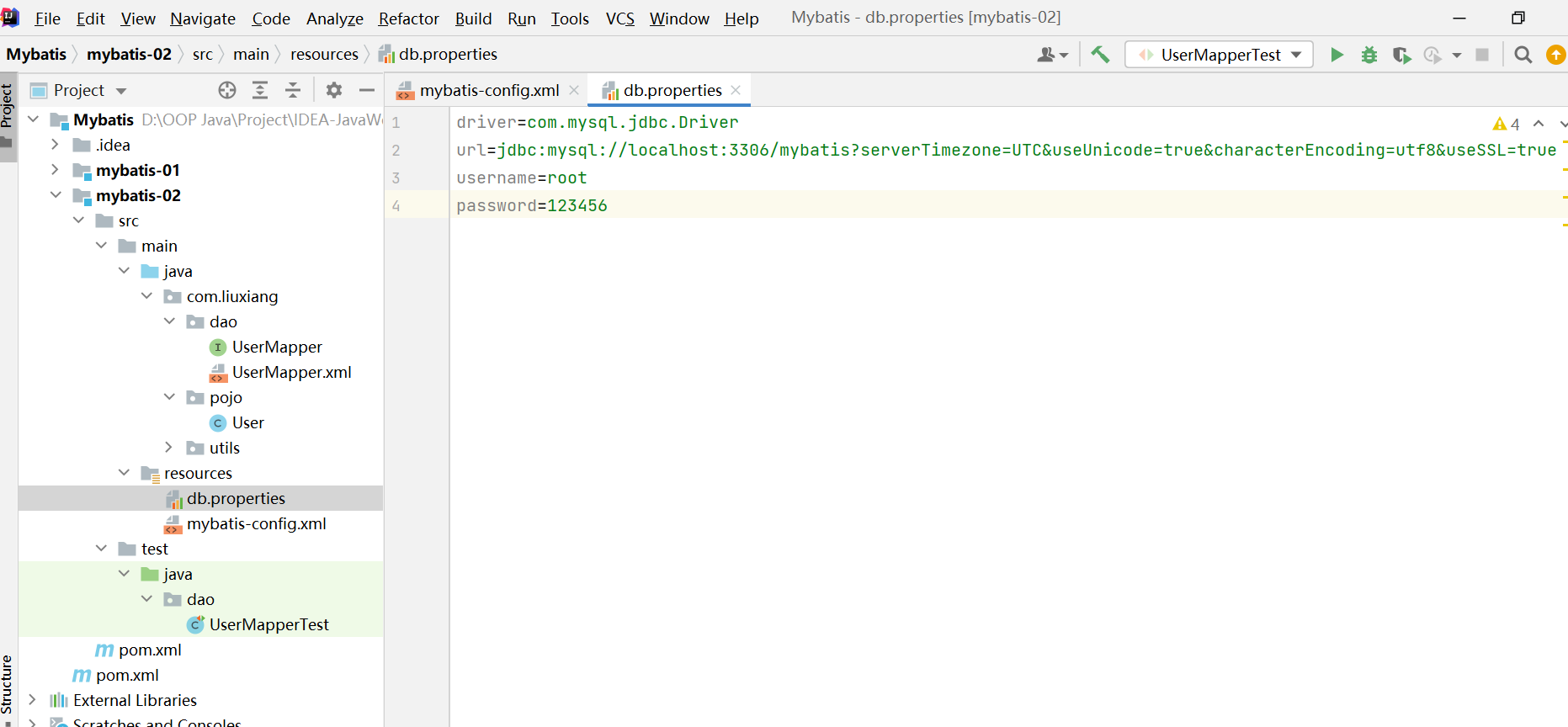
driver=com.mysql.jdbc.Driver
url=jdbc:mysql://localhost:3306/mybatis?serverTimezone=UTC&useUnicode=true&characterEncoding=utf8&useSSL=true
username=root
password=123456
- 在核心配置文件中引入
根据官方文档:标签必须在配置文件最上方,否则会报错
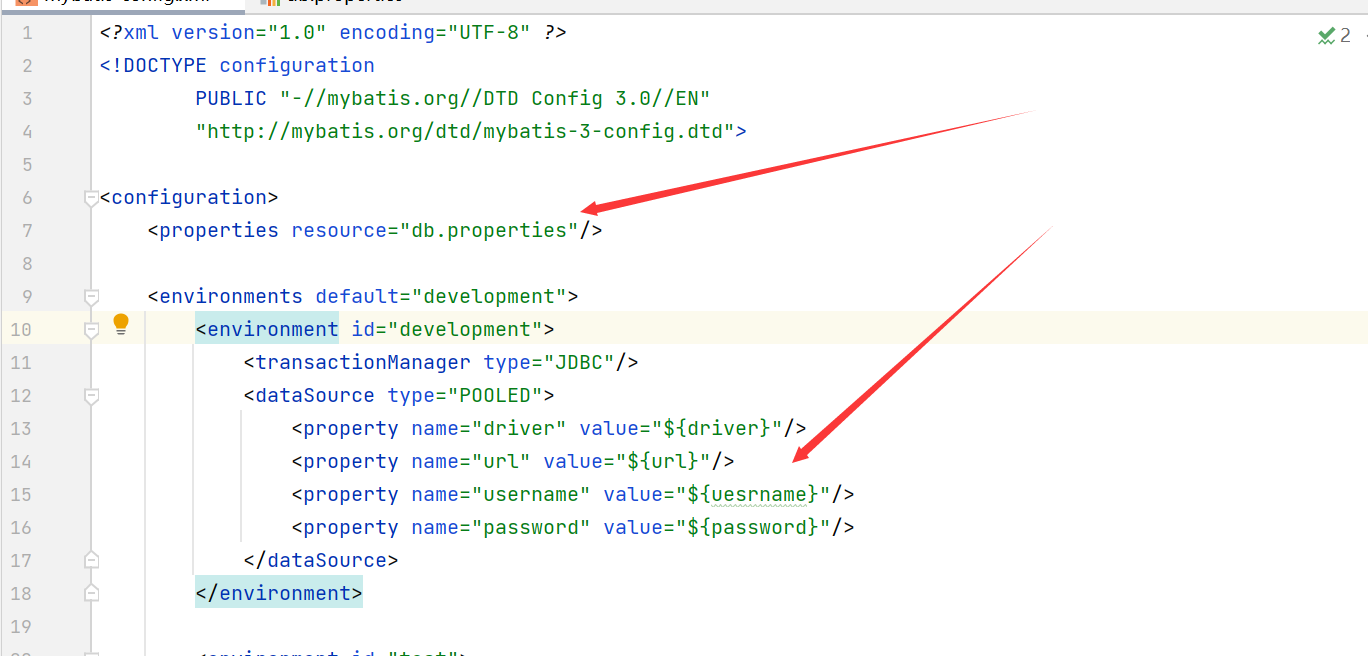
<?xml version="1.0" encoding="UTF-8" ?>
<!DOCTYPE configuration
PUBLIC "-//mybatis.org//DTD Config 3.0//EN"
"http://mybatis.org/dtd/mybatis-3-config.dtd">
<!--核心配置文件-->
<configuration>
<!--引入外部配置文件-->
<properties resource="db.properties"/>
<!--环境environments 在内配置多套环境 default指定默认环境-->
<environments default="development">
<environment id="development">
<transactionManager type="JDBC"/><!--事务管理 默认使用JDBC事务管理-->
<dataSource type="POOLED"><!--数据源-->
<!--配置数据驱动-->
<property name="driver" value="${driver}"/>
<!--配置数据库连接 数据库密码-->
<property name="url" value="${url}"/>
<property name="username" value="${username}"/>
<property name="password" value="${password}"/>
</dataSource>
</environment>
</environments>
<!--每一个Mapper配置文件中都需要在核心配置文件中注册-->
<mappers>
<mapper resource="UserMapper.xml"/>
</mappers>
</configuration>
- 也可以在properties标签增加一些其他的属性
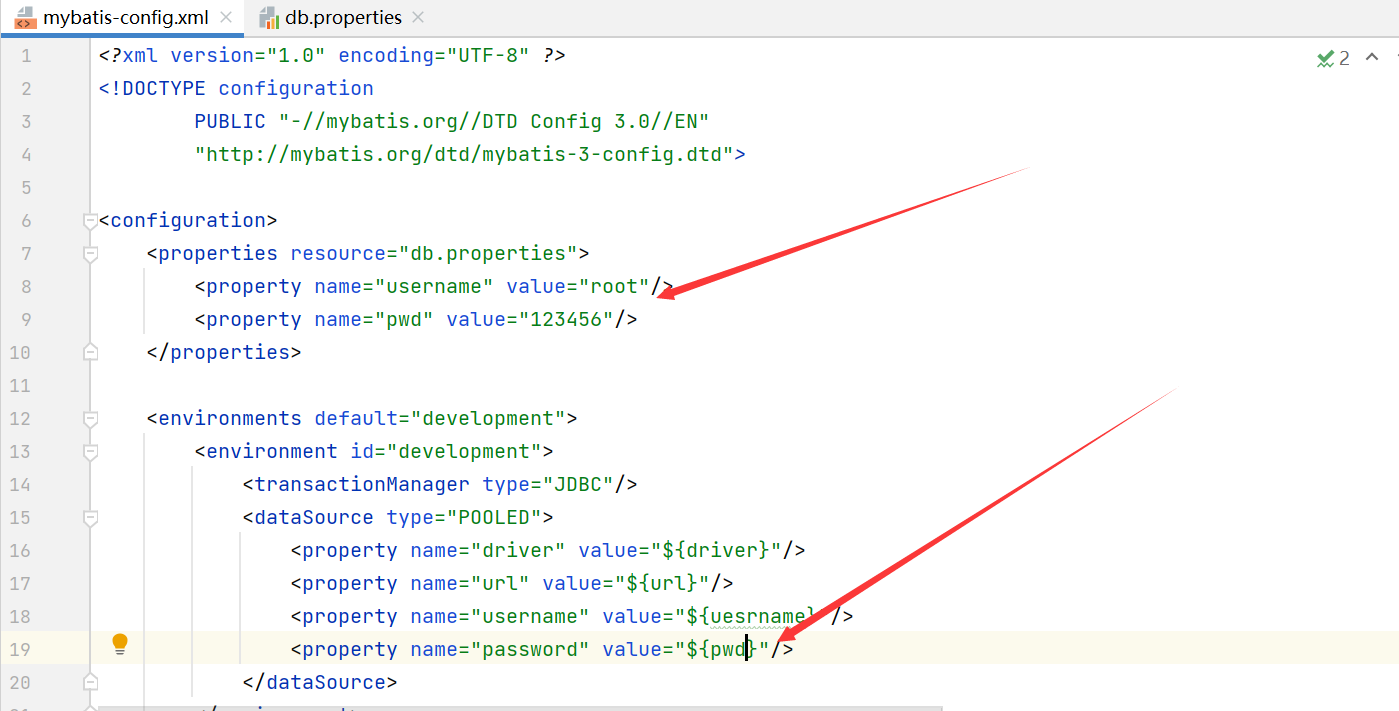
如果标签与配置文件都指定了同一个字段,优先使用properties配置文件内的
4.6、设置(settings)
这是 MyBatis 中极为重要的调整设置,它们会改变 MyBatis 的运行时行为。 下表描述了设置中各项设置的含义、默认值等。
常见使用以下配置:
<settings>
<!--开启缓存-->
<setting name="cacheEnabled" value="true"/>
<!--标准的日志工厂STDOUT_LOGGING-->
<setting name="logImpl" value="STDOUT_LOGGING"/>
<!--开启驼峰命名规则-->
<setting name="mapUnderscoreToCamelCase" value="true"/>
</settings>
sttings 标签在 properties 标签和 typeAliases 中间位置固定
4.7、类型别名(typeAliases)
- 类型别名可为 Java 类型设置一个缩写名字。
- 它仅用于 XML 配置,意在降低冗余的全限定类名书写。
- 方式一(为每个类的全限定类名,取一个特点的名字)

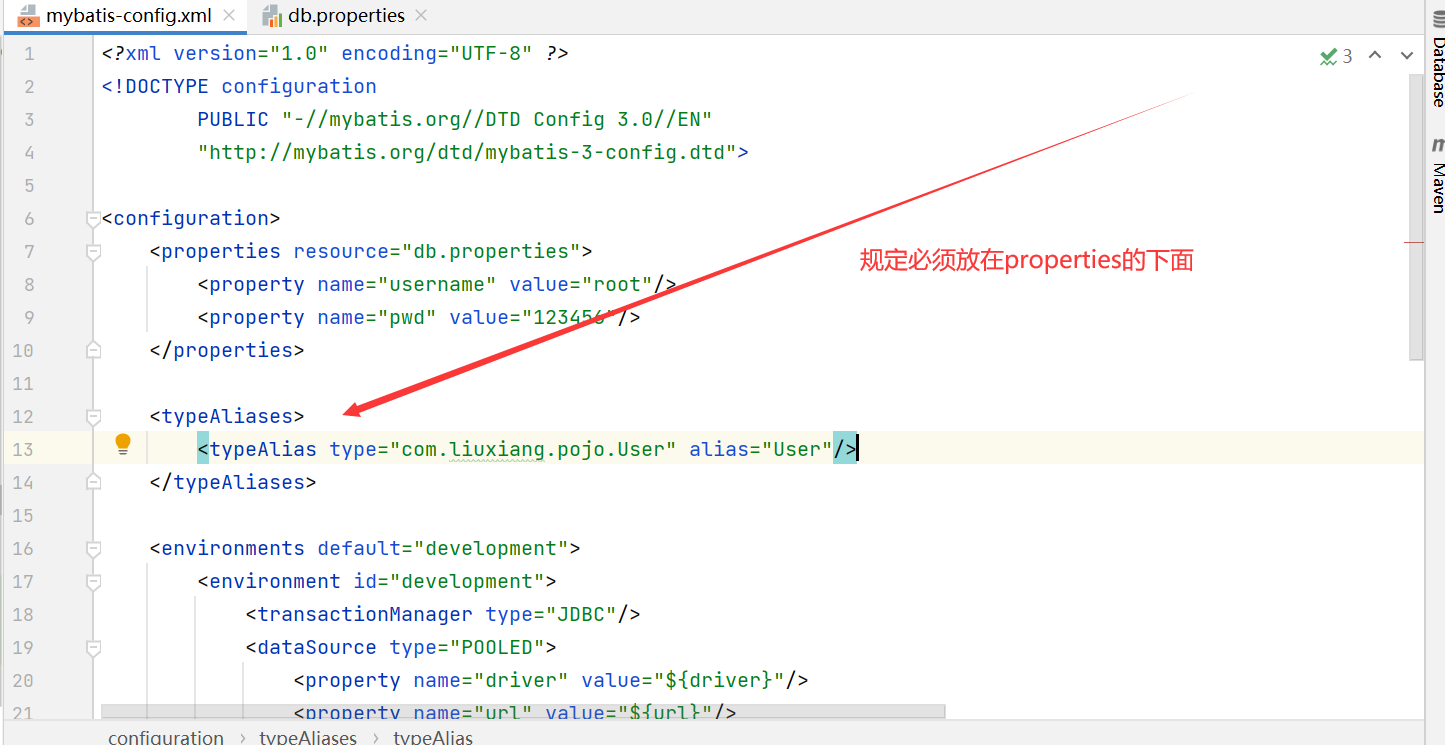
- 方式二(也可以指定一个包名,MyBatis 会在包名下面搜索需要的 Java Bean)

扫描完包,默认会使用 Bean 的首字母小写的非限定类名来作为它的别名,比如 domain.blog.Author 的别名为 author。若有注解,则别名为其注解值。

实体类比较少的时候,建议使用第一种方式。
下面是一些为常见的 Java 类型内建的类型别名。它们都是不区分大小写的,注意,为了应对原始类型的命名重复,采取了特殊的命名风格。
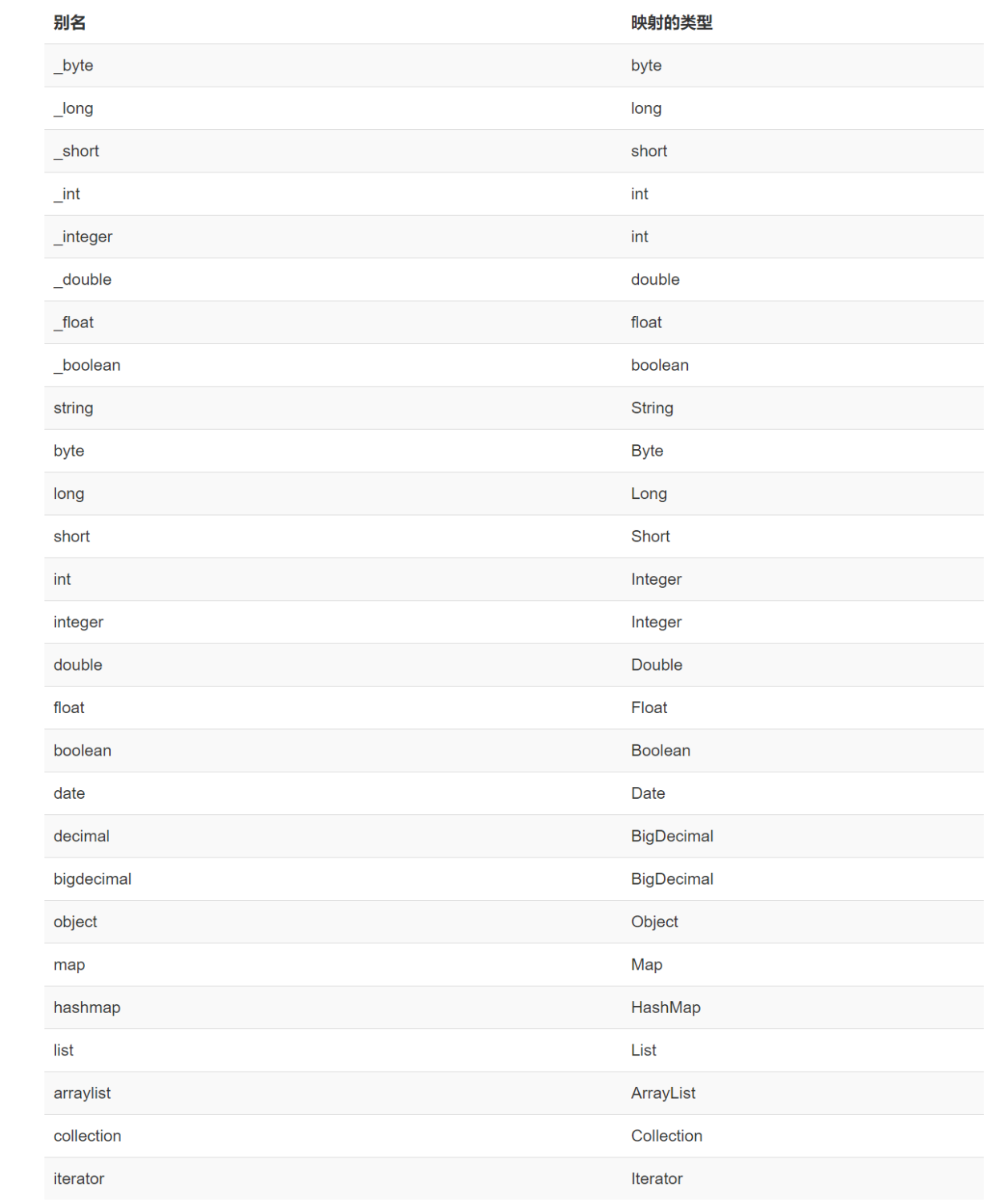
4.8、映射器(mappers)
映射器是告诉 MyBatis 到哪里去找映射文件
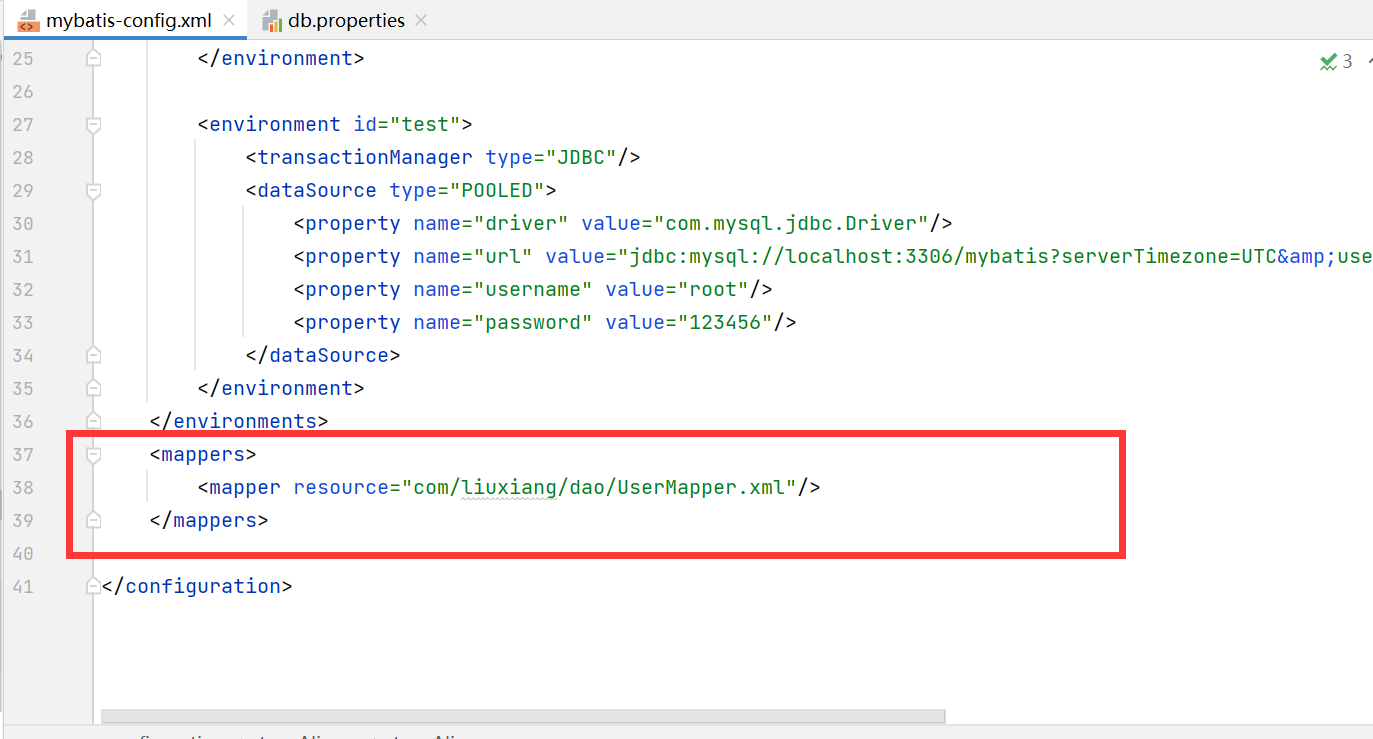
定义映射器有以下几种方式:
- 相对于类路径的资源引用(这种方式是官网推荐的)

- 使用class绑定注册

- 扫描指定包下的所有映射文件

使用方式2和方式3需注意1. 接口和他的Mapper配置文件必须同名! 2. 接口和他的Mapper配置文件必须在同一个包下!
5、ResultMap 结果集映射
ResultMap是解决实体类与数据库字段名不一致,导致查询出来的结果无法正确赋值的问题
resultMap 元素是 MyBatis 中最重要最强大的元素
ResultMap 的设计思想是,对简单的语句做到零配置,对于复杂一点的语句,只需要描述语句之间的关系就行了
5.1、问题
- 修改实体类属性,使得其与数据库字段名不一致
private int id;
private String name;
private String password;
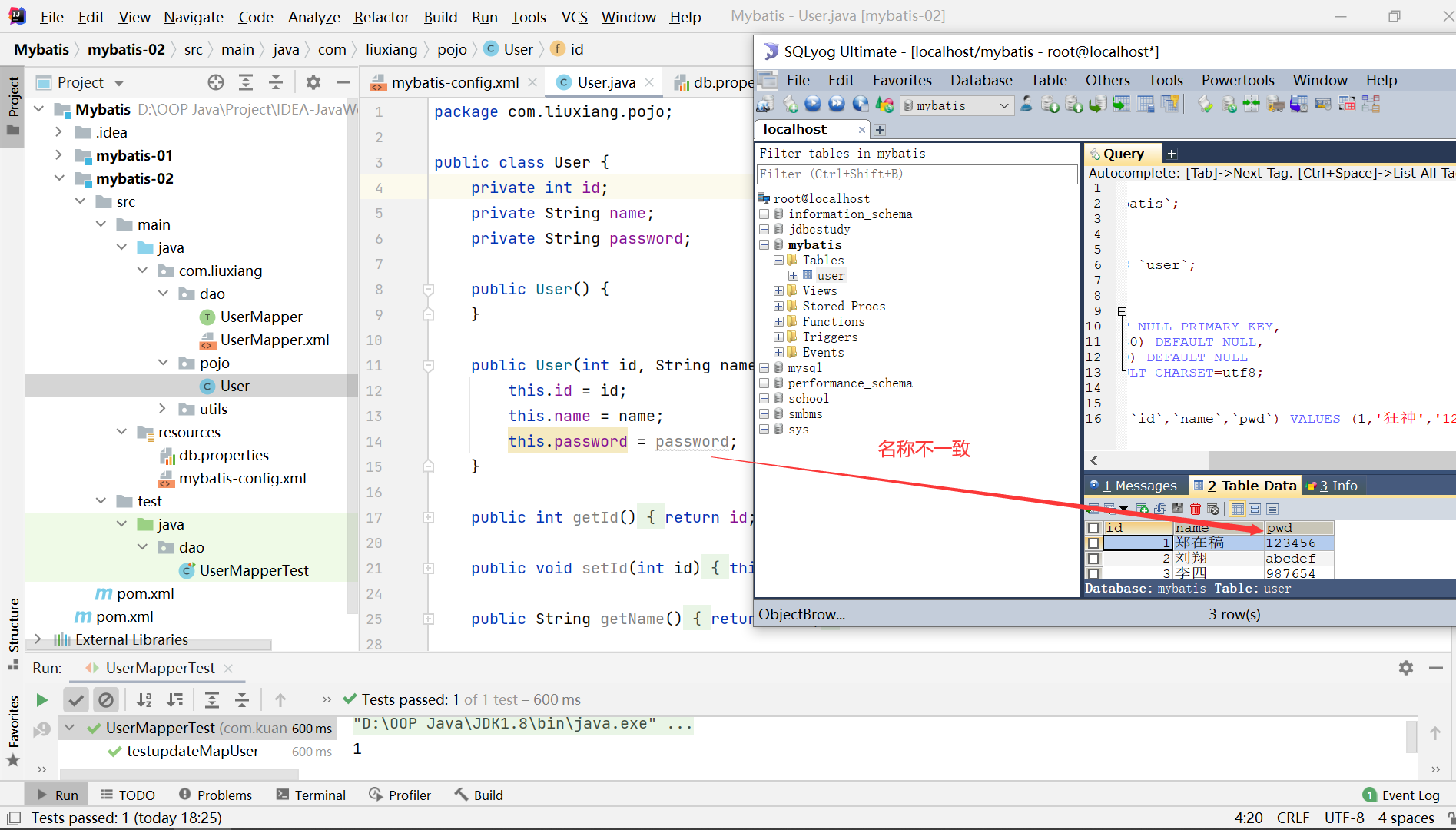
- 执行程序发现字段不匹配的属性无法查出值

5.2、解决方案
- 修改SQL语句(使用 as 起别名)
<select id="getUser" resultType="com.liuxiang.pojo.User" parameterType="int">
select id,name,pwd as password from user where id=#{id}
</select>
- 使用resultMap,修改UserMapper.xml
<!--结果集映射-->
<resultMap id="UserMap" type="com.liuxiang.pojo.User">
<!--column数据库字段 property实体类类名-->
<result column="id" property="id"/>
<result column="name" property="name"/>
<result column="pwd" property="password"/>
<result column="" property=""/>
</resultMap>
<!-- resultMap -->
<select id="getUser" resultType="com.liuxiang.pojo.User" resultMap="UserMap">
select * from user where id=#{id}
</select>
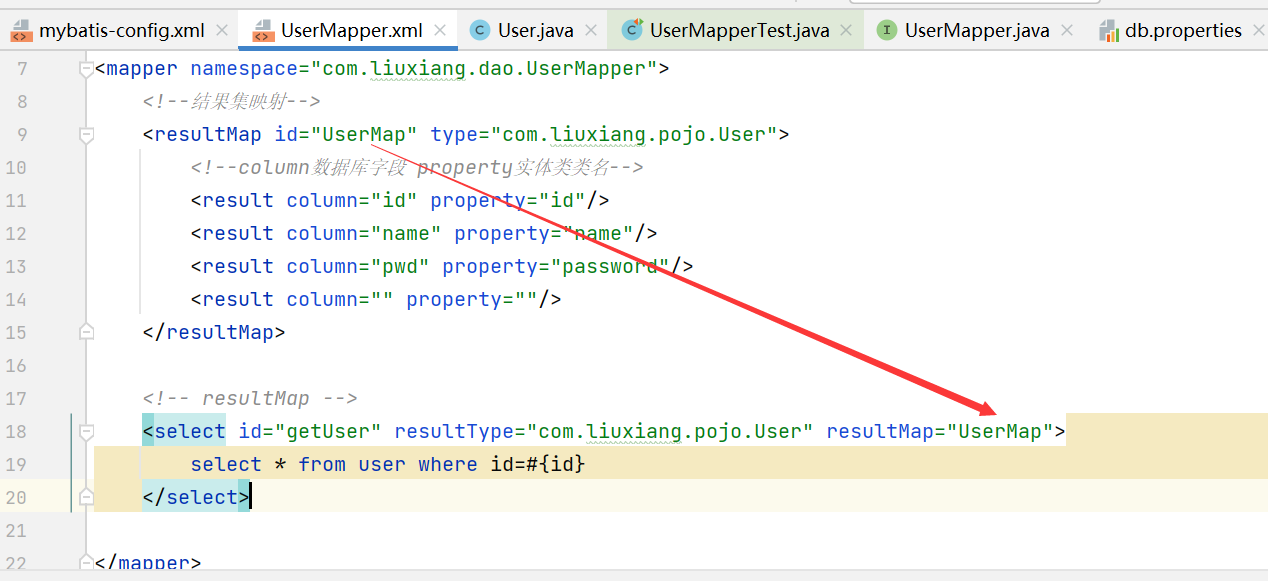
如果你已经对 resultMap 足够了解,那么有些实体类与数据库名字相同的字段,完全可以不用显示的定义出来(例如上面的 id 与 name)。
6、日志
6.1、日志工厂
在数据库的使用过程中很多时候我们需要借助日志来进行排错,在以往我们使用:sout,debug。现在Mybatis提供了日志工厂。

SLF4J
LOG4J (掌握)
LOG4J2
JDK_LOGGING
COMMONS_LOGGING
STDOUT_LOGGING (掌握)
NO_LOGGING
- 在核心配置文件中加入日志配置
<settings>
<!--标准的日志工厂STDOUT_LOGGING-->
<setting name="logImpl" value="STDOUT_LOGGING"/>
</settings>
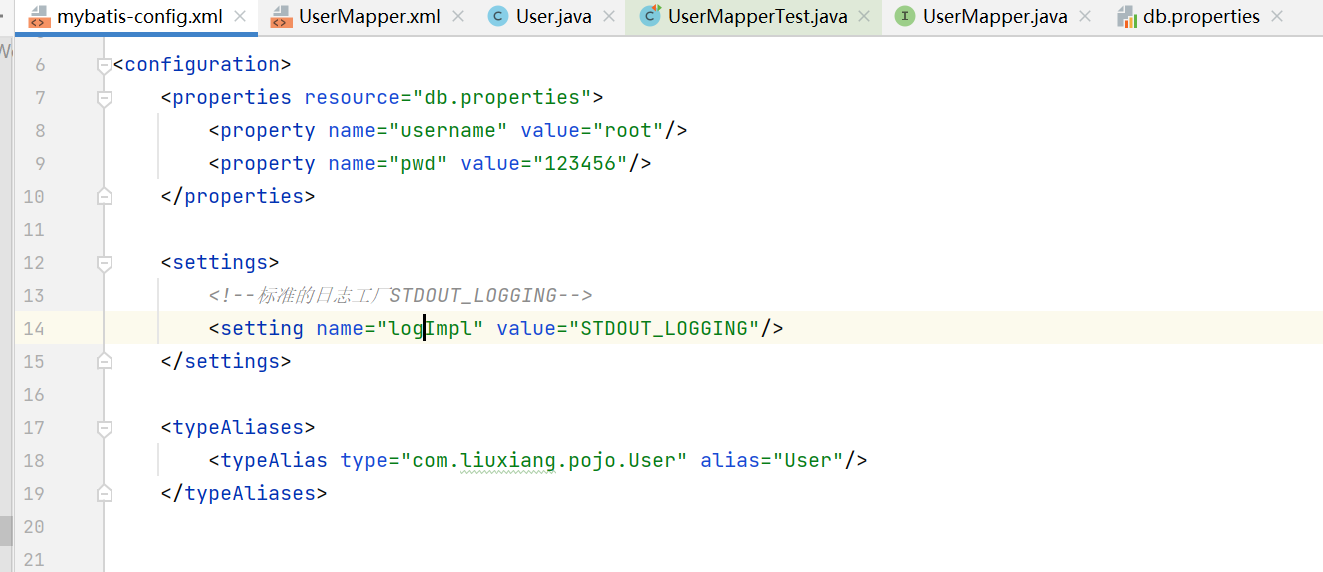
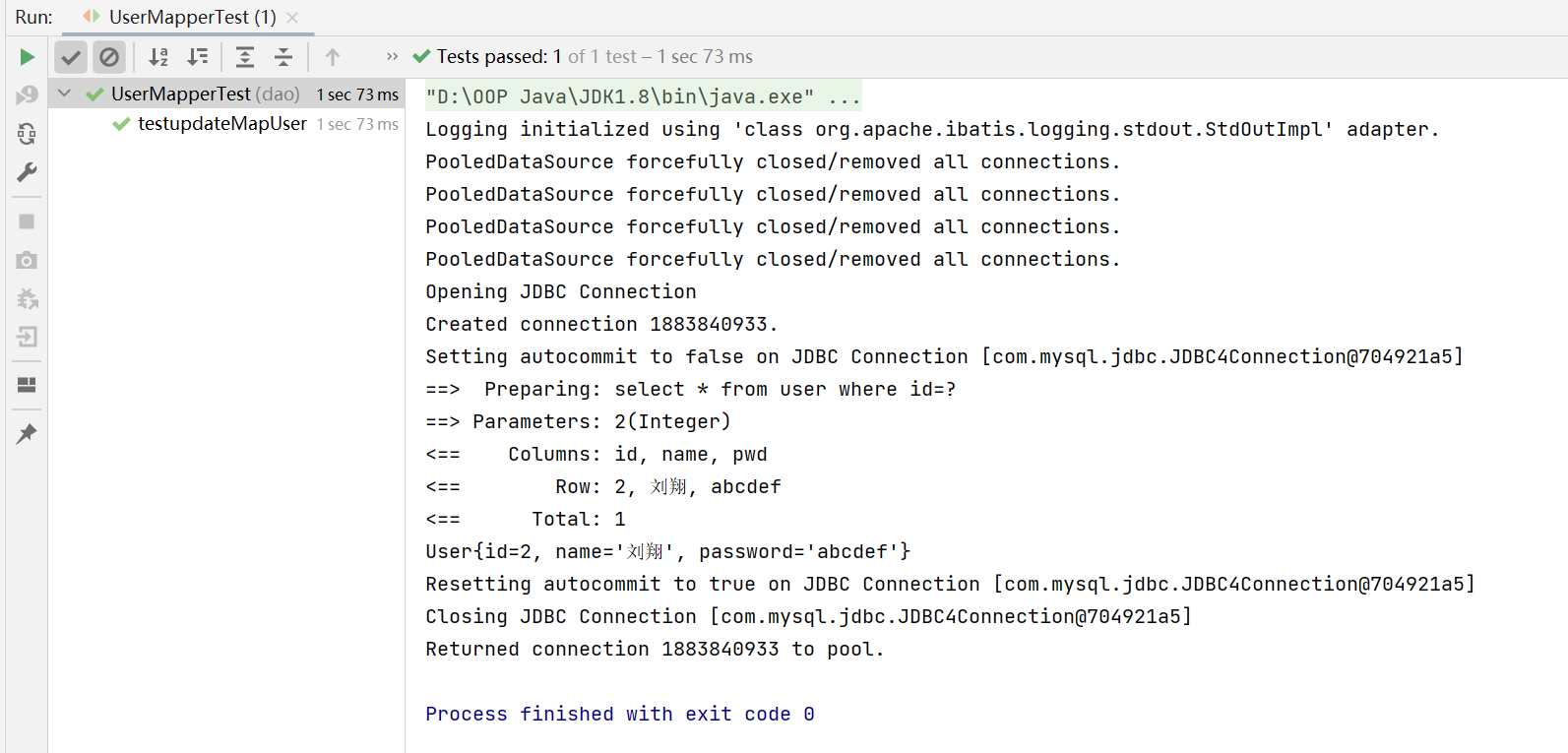
sttings 标签在 properties 标签和 typeAliases 中间位置固定,否则会报错
6.2、Log4j
-
Log4j是Apache的一个开源项目,通过使用Log4j,我们可以控制日志信息输送的目的地是控制台、文件、GUI组件,甚至是套接口服务器、NT的事件记录器、UNIX Syslog守护进程等
-
我们也可以控制每一条日志的输出格式;通过定义每一条日志信息的级别,我们能够更加细致地控制日志的生成过程
-
最令人感兴趣的就是,这些可以通过一个配置文件来灵活地进行配置,而不需要修改应用的代码。
- 导入依赖
<!-- https://mvnrepository.com/artifact/log4j/log4j -->
<dependency>
<groupId>log4j</groupId>
<artifactId>log4j</artifactId>
<version>1.2.17</version>
</dependency>
- 编写log4j.properties配置文件
#将等级为DEBUG的日志信息输出到console和file这两个目的地,console和file的定义在下面的代码
log4j.rootLogger=DEBUG,console,file
#控制台输出的相关设置
log4j.appender.console = org.apache.log4j.ConsoleAppender
log4j.appender.console.Target = System.out
log4j.appender.console.Threshold=DEBUG
log4j.appender.console.layout = org.apache.log4j.PatternLayout
log4j.appender.console.layout.ConversionPattern=[%c]-%m%n
#文件输出的相关设置
log4j.appender.file = org.apache.log4j.RollingFileAppender
log4j.appender.file.File=./log/kuang.log
log4j.appender.file.MaxFileSize=10mb
log4j.appender.file.Threshold=DEBUG
log4j.appender.file.layout=org.apache.log4j.PatternLayout
log4j.appender.file.layout.ConversionPattern=[%p][%d{yy-MM-dd}][%c]%m%n
#日志输出级别
log4j.logger.org.mybatis=DEBUG
log4j.logger.java.sql=DEBUG
log4j.logger.java.sql.Statement=DEBUG
log4j.logger.java.sql.ResultSet=DEBUG
log4j.logger.java.sql.PreparedStatement=DEBUG
- 在核心配置文件中配置Log4j日志
<settings>
<setting name="logImpl" value="LOG4J"/>
</settings>
- log4j简单测试
package dao;
import org.apache.log4j.Logger;
import org.junit.Test;
public class Log4jTest {
//注意导包:org.apache.log4j.Logger
static Logger logger = Logger.getLogger(Log4jTest.class);
@Test
public void testlog4j(){
logger.info("普通级别输出日志");
logger.debug("debug级别输出日志");
logger.error("紧急级别输出日志");
}
}
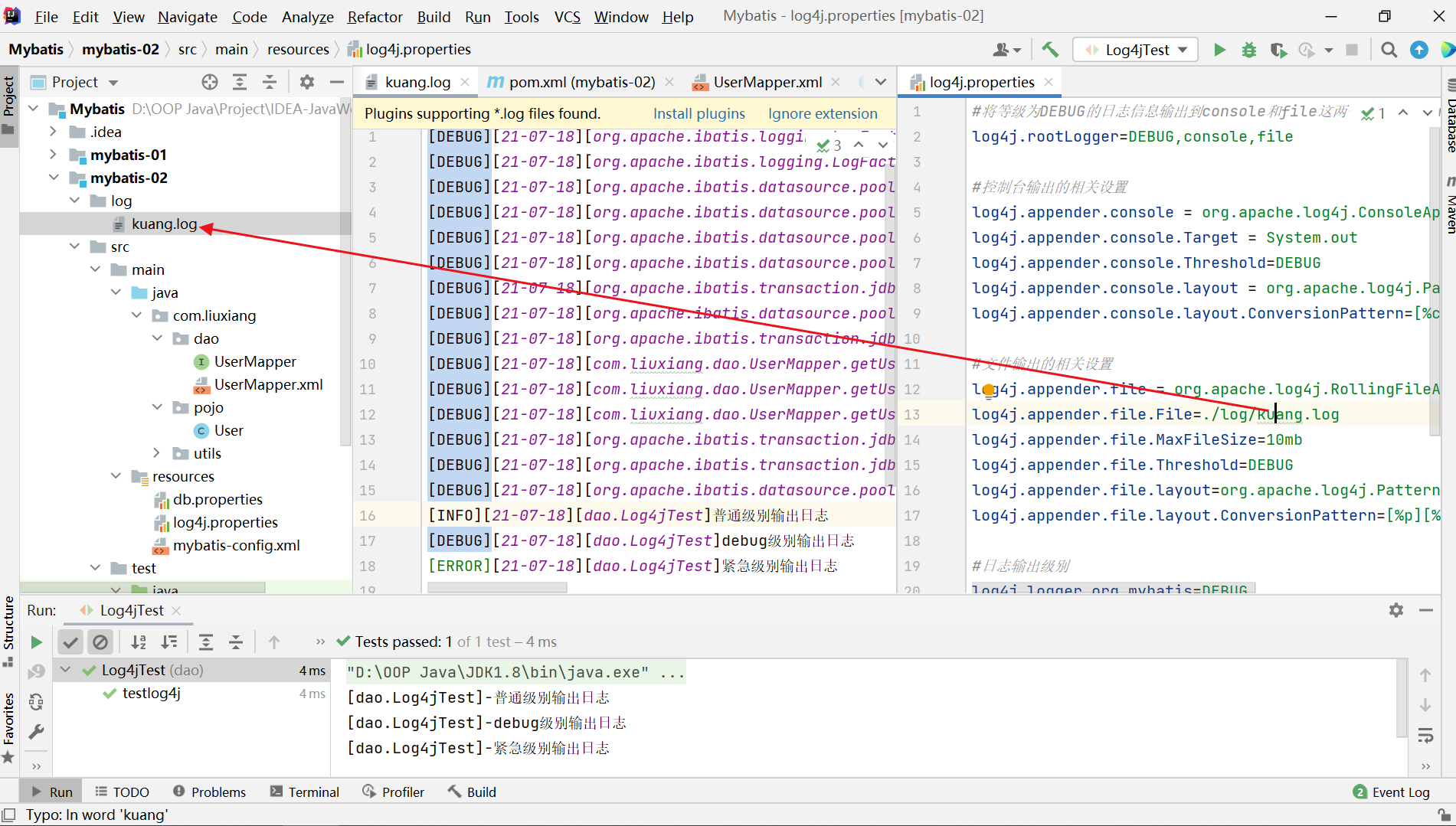
7、使用注解开发
7.1、面向接口编程
大家之前都学过面向对象编程,也学习过接口,但在真正的开发中,很多时候我们会选择面向接口编程。
- 根本原因
解耦,可拓展,提高复用,分层开发中,上层不用管具体的实现,大家都遵守共同的标准,使得开发变得容易,规范性更好。
在一个面向对象的系统中,系统的各种功能是由许许多多的不同对象协作完成的。在这种情况下,各个对象内部是如何实现自己的,对系统设计人员来讲就不那么重要了。
而各个对象之间的协作关系则成为系统设计的关键。小到不同类之间的通信,大到各模块之间的交互,在系统设计之初都是要着重考虑的,这也是系统设计的主要工作内容。面向接口编程就是指按照这种思想来编程
- 关于接口的理解
-
接口从更深层次的理解,应是定义(规范,约束)与实现(名实分离的原则)的分离。
-
接口的本身反映了系统设计人员对系统的抽象理解。
- 接口应有两类
-
第一类是对一个个体的抽象,它可对应为一个抽象体(abstract class)
-
第二类是对一个个体某一方面的抽象,即形成一个抽象面(interface)
-
一个体有可能有多个抽象面。抽象体与抽象面是有区别的。
- 三个面向区别
-
面向对象是指,我们考虑问题时,以对象为单位,考虑它的属性及方法
-
面向过程是指,我们考虑问题时,以一个具体的流程(事务过程)为单位,考虑它的实现
-
接口设计与非接口设计是针对复用技术而言的,与面向对象(过程)不是一个问题,更多的体现就是对系统整体的架构
7.2、注解
- 编写接口
@Select("select * from user")
List<User> getUsers();
- 在核心配置文件中绑定接口
<mappers>
<mapper class="com.liuxiang.dao.UserMapper"/>
</mappers>
- 编写测试类
@Test
public void Test(){
//获取sqlSession
SqlSession sqlSession = MybatisUtils.getSqlSession();
//底层主要应用反射
UserMapper mapper = sqlSession.getMapper(UserMapper.class);
List<User> userList = mapper.getUsers();
for (User user : userList) {
System.out.println(user);
}
//关闭SqlSession
sqlSession.close();
}
本质:反射机制的实现
底层:动态代理
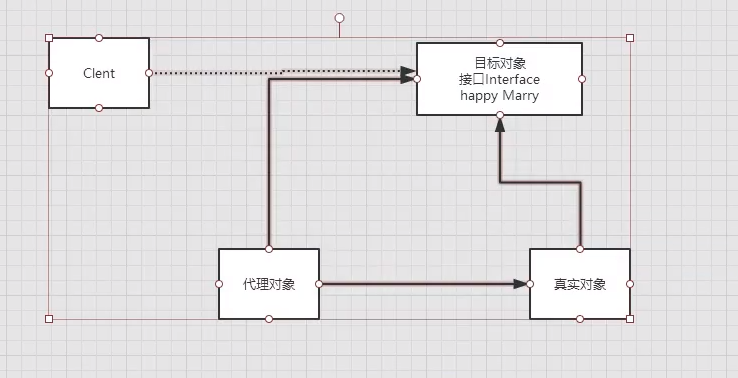
7.3、注解实现CRUD
- 编写接口
@Select("select *from user where id=#{id}")
User getUserById(@Param("id") int id);
//有多个参数的时候就必须要加@Param更加规范,是基本参数类型一般还是加上@Param更好
//参数以@Param("以这里为准")
//User getUserById(@Param("id") int id,@Param("name") String name );
@Insert("insert into user(id,name,pwd) values (#{id},#{name},#{password})")
int addUser(User user);
@Update("update user set name=#{name},pwd=#{password} where id =#{id}")
int updateUser(User user);
//参数以@Param("以这里为准") int 任意写都可以
@Delete("delete from user where id=#{id}")
int deleteUser(@Param("id") int id);
- 编写测试类
@Test
public void Test(){
//获取sqlSession
SqlSession sqlSession = MybatisUtils.getSqlSession();
//底层主要应用反射
UserMapper mapper = sqlSession.getMapper(UserMapper.class);
User userById = mapper.getUserById(2);
System.out.println(userById);
//关闭SqlSession
sqlSession.close();
}
7.4、关于@Param
- 基本参数类型或者string类型要加上
- 引用类型不需要加
- 如果只有一个参数类型的话,可以忽略,但是建议加上
- 我们在SQL中引用的就是Param()中设定的属性
7.5、#{} 和 ${} 区别
- ${ } 变量的替换阶段是在动态 SQL 解析阶段,而 #{ }变量的替换是在 DBMS 中。
- #{}方式能够很大程度防止sql注入。
- ${} 方式无法防止Sql注入。${} 方式一般用于传入数据库对象,例如传入表名。
- 一般能用#{}的就别用${},所以我们在使用mybatis的时候,尽量的使用 #{} 方式!
8、Lombok
- 在IDEA中安装 lombok
- 点击file点击Settings,找到Plugins插件。
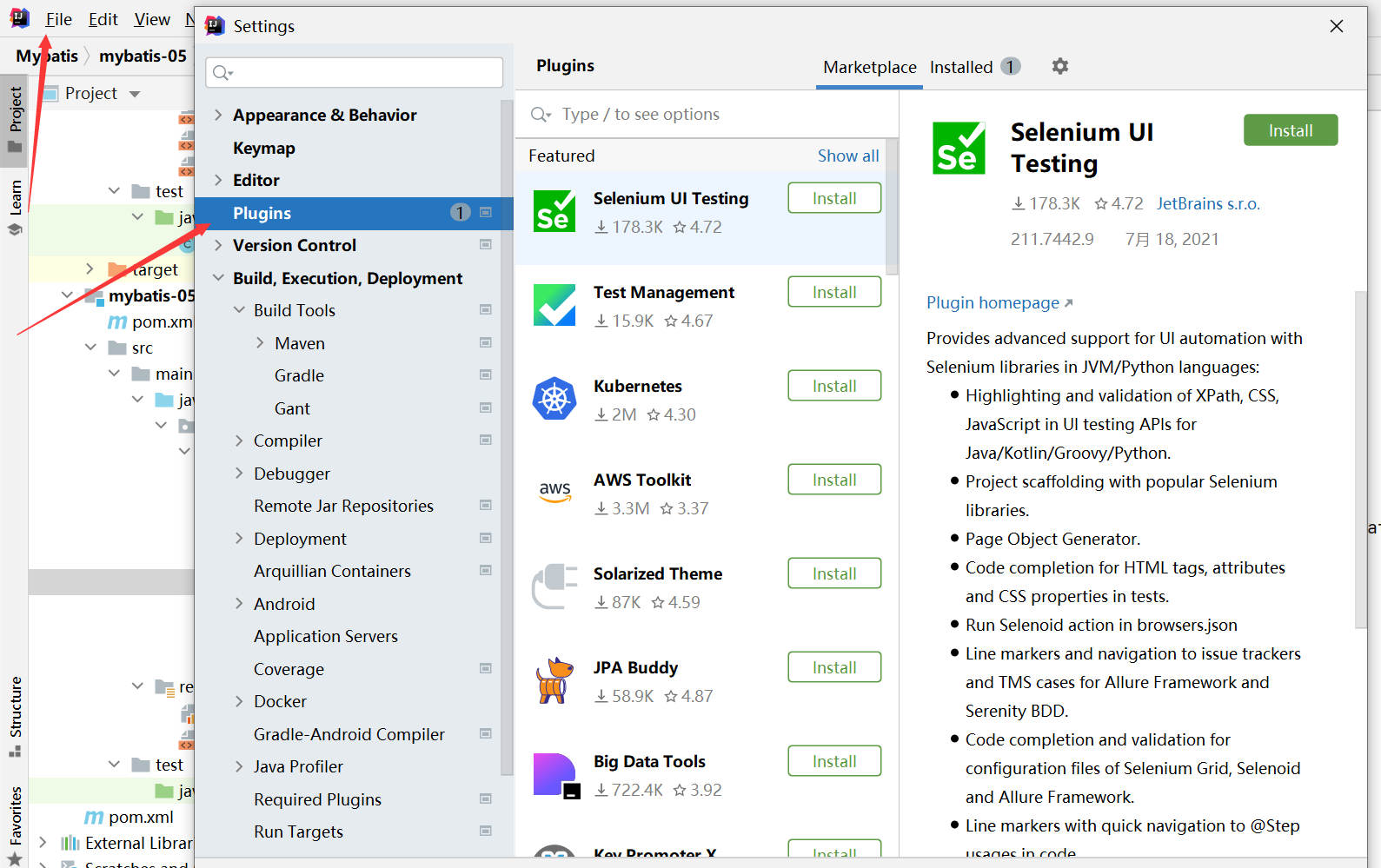
- 点击Marketplace,搜索lombok,点击installed即可安装然后重启IDEA即可。
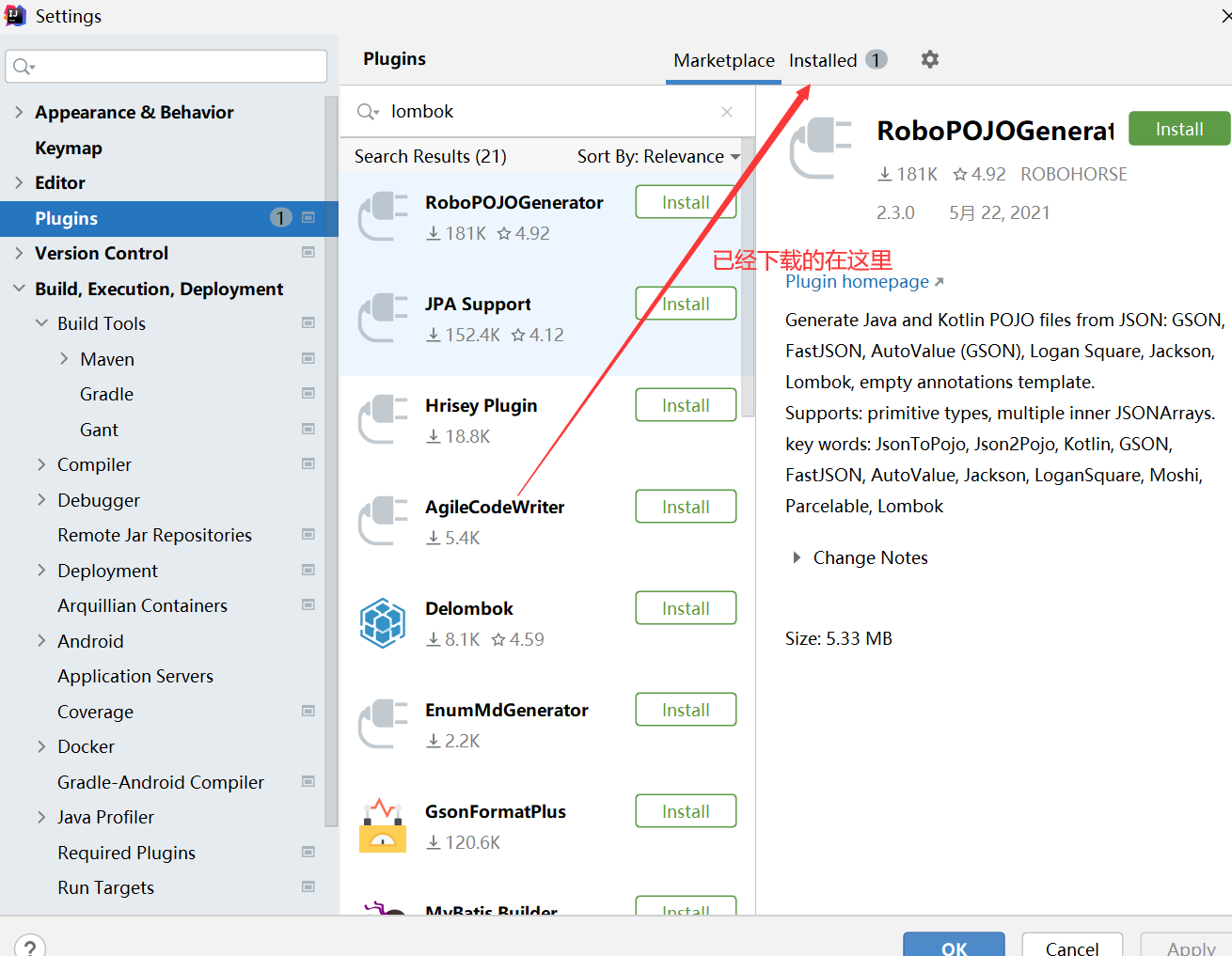
- 导入 lombok 的jar包
<dependency>
<groupId>org.projectlombok</groupId>
<artifactId>lombok</artifactId>
<version>1.18.12</version>
<scope>provided</scope>
</dependency>
- 在实体类上加注解
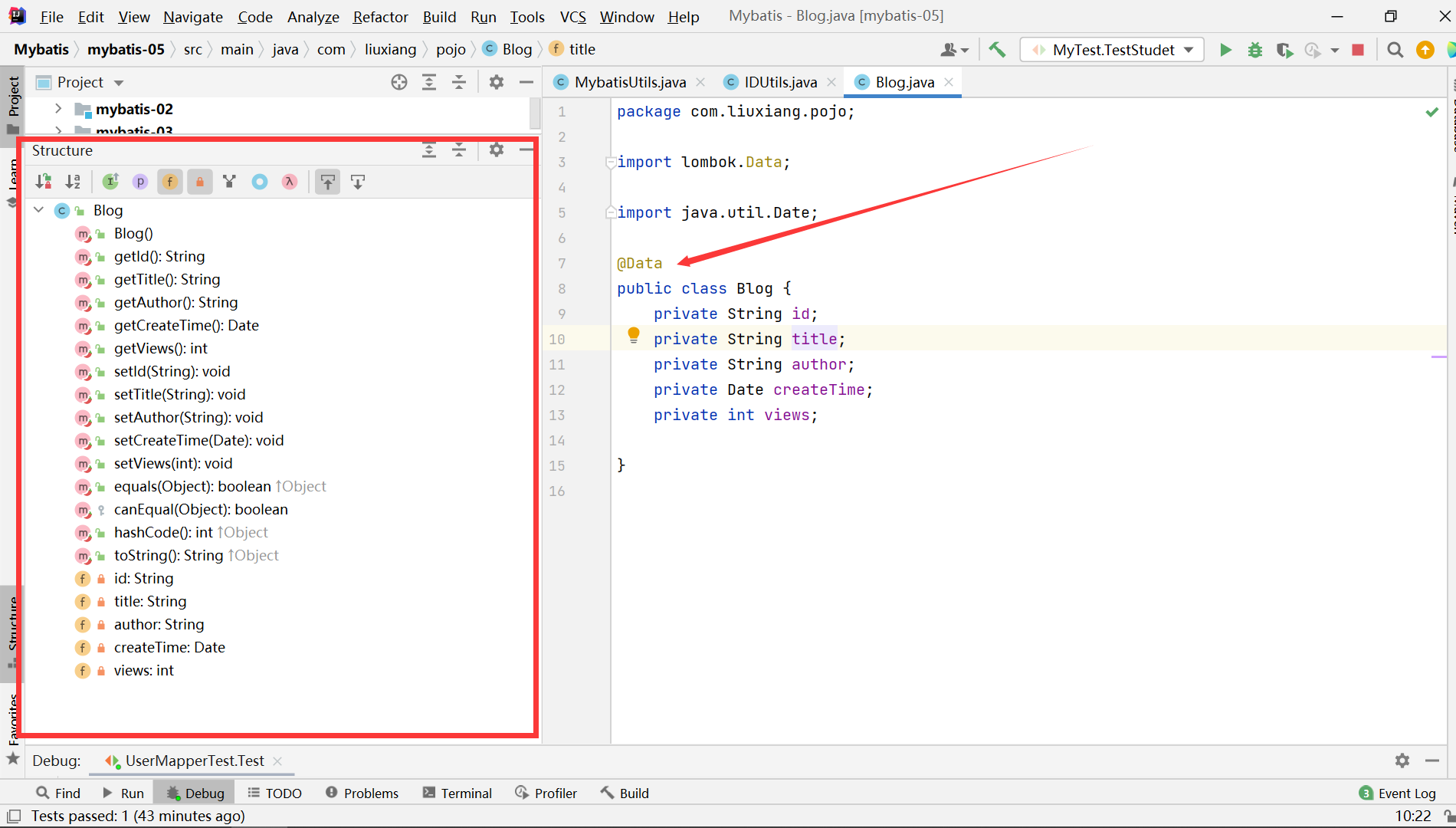
@Getter and @Setter
@FieldNameConstants
@ToString
@EqualsAndHashCode
@AllArgsConstructor, @RequiredArgsConstructor and @NoArgsConstructor
@Log, @Log4j, @Log4j2, @Slf4j, @XSlf4j, @CommonsLog, @JBossLog, @Flogger, @CustomLog
@Data
@Builder
@SuperBuilder
@Singular
@Delegate
@Value
@Accessors
@Wither
@With
@SneakyThrows
@val
-
@Data 包含无参构造,set,get,hashcode,equlas,tostring
-
@AllArgsConstructor 有参构造(使用之后@Data包含的无参构造消失,所以如果需要无参构造需要再添加@NoArgsConstructor注解)
-
@Getter and @Setter
-
@ToString
-
@EqualsAndHashCode
- Lombok的优缺点
-
优点:
-
能通过注解的形式自动生成构造器、getter/setter、equals、hashcode、toString等方法,提高了一定的开发效率
-
让代码变得简洁,不用过多的去关注相应的方法
-
属性做修改时,也简化了维护为这些属性所生成的getter/setter方法等
-
-
缺点:
- 不支持多种参数构造器的重载
- 虽然省去了手动创建getter/setter方法的麻烦,但大大降低了源代码的可读性和完整性,降低了阅读源代码的舒适度
Lombok虽然有很多优点,但Lombok更类似于一种IDE插件,项目也需要依赖相应的jar包。Lombok依赖jar包是因为编译时要用它的注解,为什么说它又类似插件?因为在使用时,eclipse或Intellij IDEA都需要安装相应的插件,在编译器编译时通过操作AST(抽象语法树)改变字节码生成,变向的就是说它在改变java语法。它不像spring的依赖注入或者mybatis的ORM一样是运行时的特性,而是编译时的特性。这里我个人最感觉不爽的地方就是对插件的依赖!因为Lombok只是省去了一些人工生成代码的麻烦,但IDE都有快捷键来协助生成getter/setter等方法,也非常方便。
8、多对一处理
-
多个学生对应一个导师
-
对学生而言关联,多个学生关联一个老师(多对一)
-
对老师而言集合,一个老师有很多学生(一对多)
8.1、复杂查询环境搭建
- 创建数据库表
-- 创建表
CREATE TABLE `teacher` (
`id` INT(10) NOT NULL,
`name` VARCHAR(30) DEFAULT NULL,
PRIMARY KEY (`id`)
) ENGINE=INNODB DEFAULT CHARSET=utf8;
-- 插入数据
INSERT INTO teacher(`id`, `name`) VALUES (1, '秦老师');
-- 创建表
CREATE TABLE `student` (
`id` INT(10) NOT NULL,
`name` VARCHAR(30) DEFAULT NULL,
`tid` INT(10) DEFAULT NULL,
PRIMARY KEY (`id`),
KEY `fktid` (`tid`),
CONSTRAINT `fktid` FOREIGN KEY (`tid`) REFERENCES `teacher` (`id`)
) ENGINE=INNODB DEFAULT CHARSET=utf8;
-- 插入数据
INSERT INTO `student` (`id`, `name`, `tid`) VALUES ('1', '小明', '1');
INSERT INTO `student` (`id`, `name`, `tid`) VALUES ('2', '小红', '1');
INSERT INTO `student` (`id`, `name`, `tid`) VALUES ('3', '小张', '1');
INSERT INTO `student` (`id`, `name`, `tid`) VALUES ('4', '小李', '1');
INSERT INTO `student` (`id`, `name`, `tid`) VALUES ('5', '小王', '1');
- 创建数据库实体类
package com.liuxiang.pojo;
public class Teacher {
private int id;
private String name;
public Teacher() {
}
public Teacher(int id, String name) {
this.id = id;
this.name = name;
}
public int getId() {
return id;
}
public void setId(int id) {
this.id = id;
}
public String getName() {
return name;
}
public void setName(String name) {
this.name = name;
}
@Override
public String toString() {
return "Teacher{" +
"id=" + id +
", name='" + name + '\'' +
'}';
}
}
package com.liuxiang.pojo;
public class Student {
private int id;
private String name;
//学生关联一个老师
private Teacher teacher;
public Student() {
}
public Student(int id, String name, Teacher teacher) {
this.id = id;
this.name = name;
this.teacher = teacher;
}
public int getId() {
return id;
}
public void setId(int id) {
this.id = id;
}
public String getName() {
return name;
}
public void setName(String name) {
this.name = name;
}
public Teacher getTeacher() {
return teacher;
}
public void setTeacher(Teacher teacher) {
this.teacher = teacher;
}
@Override
public String toString() {
return "Student{" +
"id=" + id +
", name='" + name + '\'' +
", teacher=" + teacher +
'}';
}
}
- 创建接口
package com.liuxiang.dao;
public interface TeacherMapper {
}
package com.liuxiang.dao;
public interface StudentMapper {
}
- 创建Mapper.xml配置文件
<?xml version="1.0" encoding="UTF8" ?>
<!DOCTYPE mapper
PUBLIC "-//mybatis.org//DTD Mapper 3.0//EN"
"http://mybatis.org/dtd/mybatis-3-mapper.dtd">
<!--namespace 命名空间 指向 定义一个Dao接口-->
<mapper namespace="com.liuxiang.dao.TeacherMapper"><!--定义接口全路径名-->
</mapper>
<?xml version="1.0" encoding="UTF8" ?>
<!DOCTYPE mapper
PUBLIC "-//mybatis.org//DTD Mapper 3.0//EN"
"http://mybatis.org/dtd/mybatis-3-mapper.dtd">
<!--namespace 命名空间 指向 定义一个Dao接口-->
<mapper namespace="com.liuxiang.dao.StudentMapper"><!--定义接口全路径名-->
</mapper>
- 核心配置文件中添加映射并起别名
<typeAliases>
<typeAlias type="com.liuxiang.pojo.Teacher" alias="teacher"/>
<typeAlias type="com.liuxiang.pojo.Student" alias="student"/>
</typeAliases>
<mappers>
<mapper resource="TeacherMapper.xml"/>
<mapper resource="StudentMapper.xml"/>
</mappers>
8.2、多对一的处理
需求:查询所有学生以及对应的老师信息
- 编辑学生接口
// 查询所有的学生信息,以及对应的老师的信息
public List<Student> getStudent();
public List<Student> getStudent2();
- 编写映射文件
- 按照查询嵌套处理–子查询
<?xml version="1.0" encoding="UTF8" ?>
<!DOCTYPE mapper
PUBLIC "-//mybatis.org//DTD Mapper 3.0//EN"
"http://mybatis.org/dtd/mybatis-3-mapper.dtd">
<!--namespace 命名空间 指向 定义一个Dao接口-->
<mapper namespace="com.liuxiang.dao.StudentMapper"><!--定义接口全路径名-->
<resultMap id="studentmap" type="student">
<!--column数据库字段 property实体类类名-->
<result property="id" column="id"/>
<result property="name" column="name"/>
<!--复杂属性 需要单独处理
如果字段为对象 选择association
如果字段为集合 使用collection-->
<association property="teacher" column="tid" javaType="teacher" select="getTeacher"/>
</resultMap>
<!--查询所有学生 以及对应的老师信息 resultMap结果集映射-->
<select id="getStudent" resultMap="studentmap">
select * from student
</select>
<select id="getTeacher" resultType="teacher">
select * from teacher where id =#{tid}
</select>
</mapper>
@Test
public void TestStudet (){
SqlSession sqlSession = MybatisUtils.getSqlSession();
StudentMapper mapper = sqlSession.getMapper(StudentMapper.class);
List<Student> student = mapper.getStudent();
for (Student stu:student) {
System.out.println(stu);
}
sqlSession.close();
}
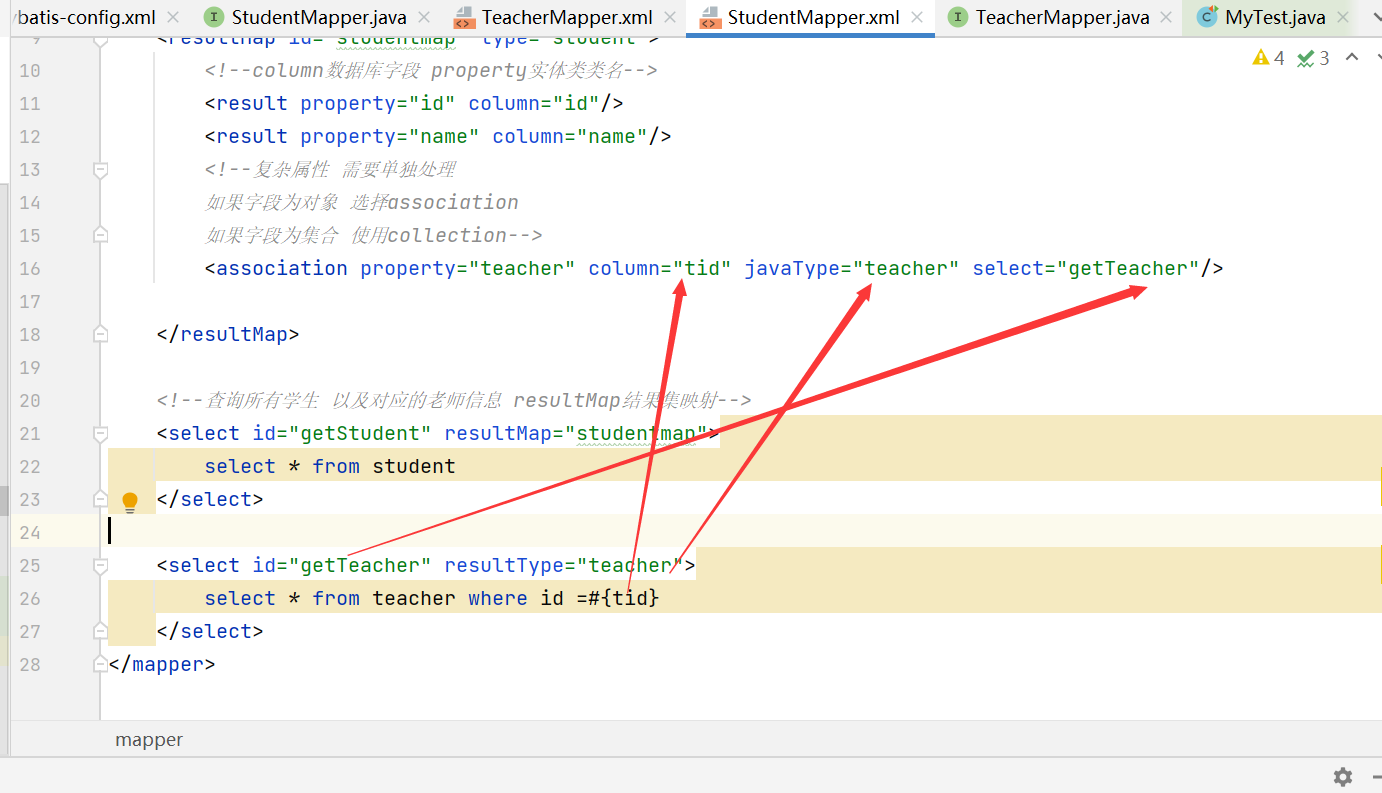
- 按照结果嵌套处理–联表查询
<?xml version="1.0" encoding="UTF8" ?>
<!DOCTYPE mapper
PUBLIC "-//mybatis.org//DTD Mapper 3.0//EN"
"http://mybatis.org/dtd/mybatis-3-mapper.dtd">
<!--namespace 命名空间 指向 定义一个Dao接口-->
<mapper namespace="com.liuxiang.dao.StudentMapper"><!--定义接口全路径名-->
<select id="getStudent2" resultMap="StudentTeacher2">
select s.id sid,s.name sname,t.name tname
from student s,teacher t
where s.tid=t.id;
</select>
<resultMap id="StudentTeacher2" type="Student">
<result property="id" column="sid"/>
<result property="name" column="sname"/>
<association property="teacher" javaType="teacher">
<result property="name" column="tname"/>
</association>
</resultMap>
</mapper>
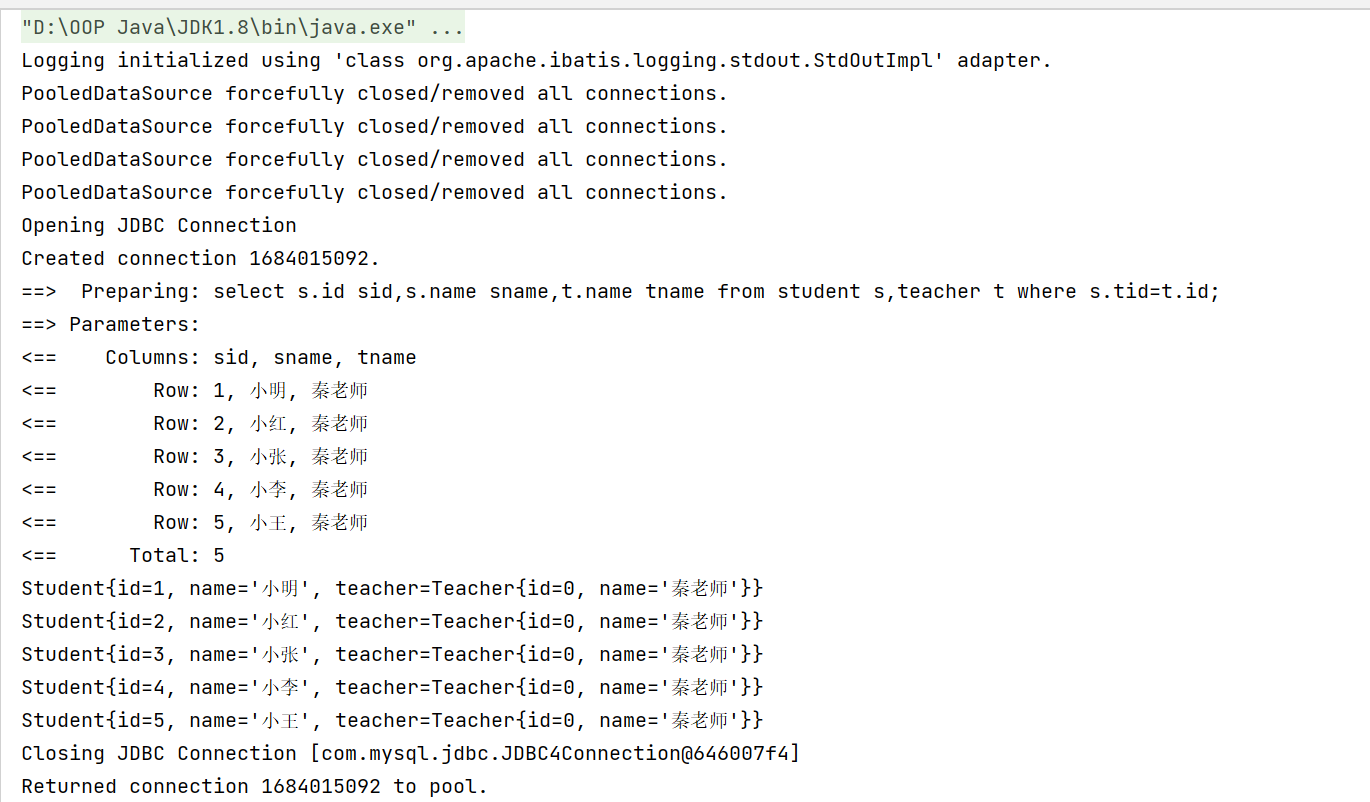
8.3、一对多的处理
- 修改实体类
package com.liuxiang.pojo;
public class Student {
private int id;
private String name;
//学生关联一个老师
private int tid;
public Student() {
}
public Student(int id, String name, int tid) {
this.id = id;
this.name = name;
this.tid = tid;
}
public int getId() {
return id;
}
public void setId(int id) {
this.id = id;
}
public String getName() {
return name;
}
public void setName(String name) {
this.name = name;
}
public int getTid() {
return tid;
}
public void setTid(int tid) {
this.tid = tid;
}
@Override
public String toString() {
return "Student{" +
"id=" + id +
", name='" + name + '\'' +
", tid=" + tid +
'}';
}
}
package com.liuxiang.pojo;
import java.util.List;
public class Teacher {
private int id;
private String name;
private List<Student> student;
public Teacher() {
}
public Teacher(int id, String name, List<Student> student) {
this.id = id;
this.name = name;
this.student = student;
}
public int getId() {
return id;
}
public void setId(int id) {
this.id = id;
}
public String getName() {
return name;
}
public void setName(String name) {
this.name = name;
}
public List<Student> getStudent() {
return student;
}
public void setStudent(List<Student> student) {
this.student = student;
}
@Override
public String toString() {
return "Teacher{" +
"id=" + id +
", name='" + name + '\'' +
", student=" + student +
'}';
}
}
- 编辑老师接口
//查询指定老师下的所有学生信息及老师信息
public Teacher getTeacher(@Param("tid") int id);
public Teacher getTeacher2(@Param("tid") int id);
- 编写映射文件
- 按照结果嵌套处理–联表查询
<?xml version="1.0" encoding="UTF8" ?>
<!DOCTYPE mapper
PUBLIC "-//mybatis.org//DTD Mapper 3.0//EN"
"http://mybatis.org/dtd/mybatis-3-mapper.dtd">
<!--namespace 命名空间 指向 定义一个Dao接口-->
<mapper namespace="com.liuxiang.dao.TeacherMapper"><!--定义接口全路径名-->
<select id="getTeacher" resultMap="TeacherStudent">
select s.id sid,s.name sname,t.name tnamr,t.id tid
from student s,teacher t
where s.tid= t.id and t.id=#{tid};
</select>
<resultMap id="TeacherStudent" type="teacher">
<result property="id" column="tid"/>
<result property="name" column="tname"/>
<collection property="student" ofType="student">
<result property="id" column="sid"/>
<result property="name" column="sname"/>
<result property="tid" column="tid"/>
</collection>
</resultMap>
</mapper>
@Test
public void TestStudet (){
SqlSession sqlSession = MybatisUtils.getSqlSession();
TeacherMapper mapper = sqlSession.getMapper(TeacherMapper.class);
Teacher teacher = mapper.getTeacher(1);
System.out.println(teacher);
sqlSession.close();
}
- 按照查询嵌套处理–子查询
<?xml version="1.0" encoding="UTF8" ?>
<!DOCTYPE mapper
PUBLIC "-//mybatis.org//DTD Mapper 3.0//EN"
"http://mybatis.org/dtd/mybatis-3-mapper.dtd">
<!--namespace 命名空间 指向 定义一个Dao接口-->
<mapper namespace="com.liuxiang.dao.TeacherMapper"><!--定义接口全路径名-->
<select id="getTeacher2" resultMap="TeacherStudent2">
SELECT * FROM teacher WHERE id = #{tid}
</select>
<resultMap id="TeacherStudent2" type="teacher">
<collection property="student" javaType="ArrayList" ofType="student" select="getStudentByTeacherId" column="id"/>
</resultMap>
<select id="getStudentByTeacherId" resultType="student">
select * from student where tid = #{tid}
</select>
</mapper>
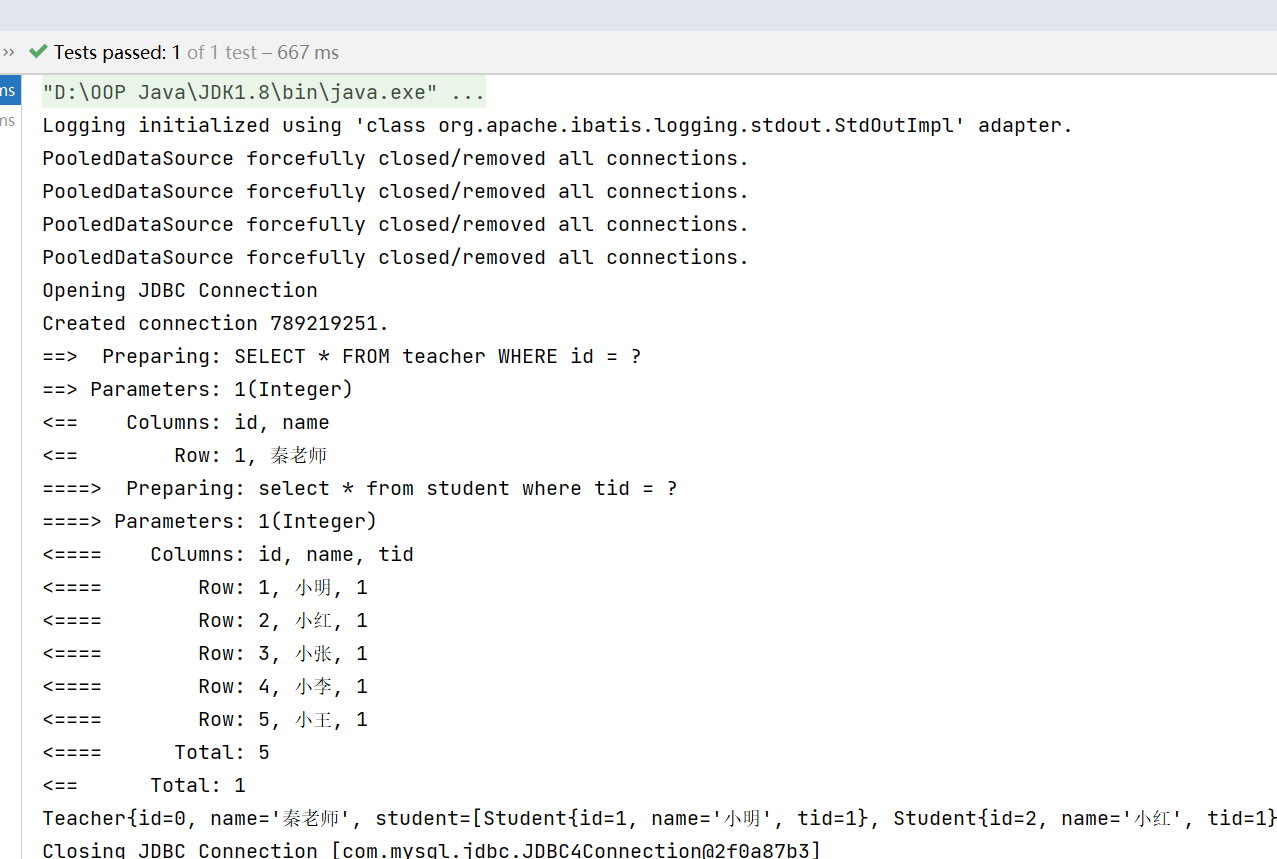
8.4、小结
-
关联:association 【多对一】
-
集合:collection 【一对多】
-
javaType & ofType
- javaType 用来指定实体类中属性的类型
- ofType 用来指定映射到 List 或者集合中的 pojo 类型,泛型中的约束类型
-
注意点:
- 保证sql的可读性尽量保持通俗易懂
- 注意一对多和多对一中,属性和字段的问题
- 如果不好排查建议使用log4j日志
9、动态SQL
什么是动态SQL:动态SQL就是指根据不同的条件生成不同的SQL

9.1、搭建环境
- 创建数据库表
-- 创建表
CREATE TABLE `blog` (
`id` VARCHAR(50) NOT NULL COMMENT '博客id',
`title` VARCHAR(100) NOT NULL COMMENT '博客标题',
`author` VARCHAR(30) NOT NULL COMMENT '博客作者',
`create_time` DATETIME NOT NULL COMMENT '创建时间',
`views` INT(30) NOT NULL COMMENT '浏览量'
) ENGINE=INNODB DEFAULT CHARSET=utf8;
- 创建POJO实体类
package com.liuxiang.pojo;
import lombok.Data;
import java.util.Date;
@Data
public class Blog {
private String id;
private String title;
private String author;
private Date createTime;
private int views;
}
- 编写接口
package com.liuxiang.dao;
public interface BlogMapper {
}
- 编写xml映射文件
<?xml version="1.0" encoding="UTF8" ?>
<!DOCTYPE mapper
PUBLIC "-//mybatis.org//DTD Config 3.0//EN"
"http://mybatis.org/dtd/mybatis-3-mapper.dtd">
<mapper namespace="com.liuxiang.dao.BlogMapper">
</mapper>
- 在核心配置文件中引入
<mappers>
<mapper resource="com/liuxiang/dao/BlogMapper.xml"/>
</mappers>
- 编写UUID工具类
package com.liuxiang.utils;
import java.util.UUID;
public class IDUtils {
public static String getId(){
return UUID.randomUUID().toString().replaceAll("-","");
}
}
- 在核心配置文件中设置开启驼峰命名映射
<settings>
<setting name="logImpl" value="STDOUT_LOGGING"/>
<!--开启驼峰命名规则-->
<setting name="mapUnderscoreToCamelCase" value="true"/>
</settings>
- 增加数据
- 编写接口
//插入数据
public int insertBlog(Blog blog);
- 在
BlogMapper.xml中新增SQL映射
<insert id="insertBlog" parameterType="blog">
insert into blog (id,title,author,create_time,views)
values (#{id},#{title},#{author},#{createTime},#{views});
</insert>
- 编写插入数据程序
import com.liuxiang.dao.BlogMapper;
import com.liuxiang.pojo.Blog;
import com.liuxiang.utils.IDUtils;
import com.liuxiang.utils.MybatisUtils;
import org.apache.ibatis.session.SqlSession;
import org.junit.Test;
import java.util.Date;
public class InsertTest {
@Test
public void testaddBlog(){
SqlSession session = MybatisUtils.getSqlSession();
BlogMapper mapper = session.getMapper(BlogMapper.class);
Blog blog = new Blog();
blog.setId(IDUtils.getId());
blog.setTitle("Mybatis如此简单");
blog.setAuthor("狂神说");
blog.setCreateTime(new Date());
blog.setViews(9999);
mapper.insertBlog(blog);
blog.setId(IDUtils.getId());
blog.setTitle("Java如此简单");
mapper.insertBlog(blog);
blog.setId(IDUtils.getId());
blog.setTitle("Spring如此简单");
mapper.insertBlog(blog);
blog.setId(IDUtils.getId());
blog.setTitle("微服务如此简单");
mapper.insertBlog(blog);
session.close();
}
}

9.2、if 标签

- 编写接口
//查询博客
public List<Blog> getBlog(Map map);
- 编写XML文件
<!--查询-->
<select id="getBlog" parameterType="map" resultType="blog">
select * from blog where 1=1
/*如果传入author或title则匹配后面的值*/
<if test="author != null">and author=#{author} </if>
<if test="title != null"> and title=#{title}</if>
</select>
- 编写测试类
@Test
public void testSelectBlog(){
SqlSession session = MybatisUtils.getSqlSession();
BlogMapper mapper = session.getMapper(BlogMapper.class);
Map<String, String> map = new HashMap();
map.put("title","Java如此简单");
List<Blog> list = mapper.getBlog(map);
for (Blog blog : list) {
System.out.println(blog);
}
session.close();
}
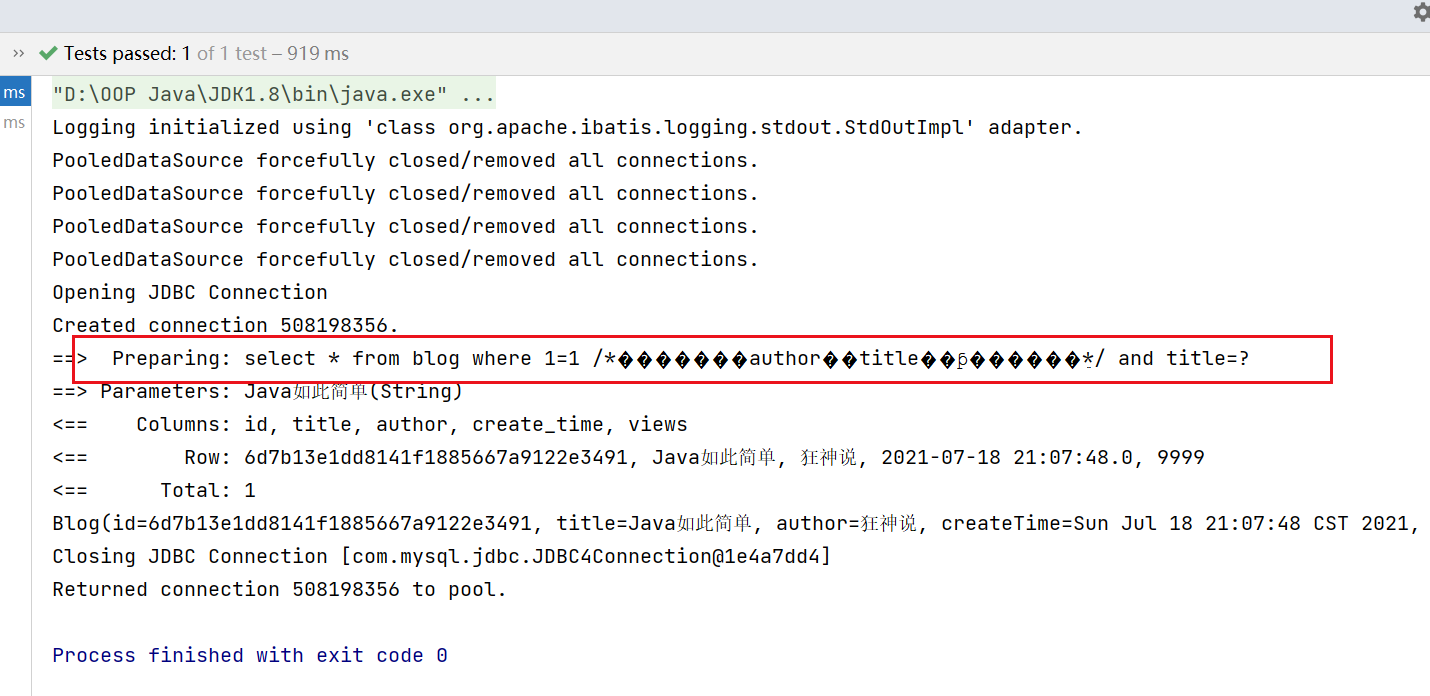
9.3、trim、where、set标签
- where标签
在实际生产环境,SQL不能用 where 1=1 这样不安全的查询,可以使用 where 标签匹配后面的查询
<!--查询-->
<!--如果传入author或title则匹配后面的值-->
<select id="getBlog" parameterType="map" resultType="blog">
select * from blog
<where>
<if test="author != null">author=#{author} </if>
<if test="title != null"> and title=#{title}</if>
</where>
</select>
where 元素只会在子元素返回任何内容的情况下才插入 “WHERE” 子句。而且,若子句的开头为 “AND” 或 “OR”,where 元素也会将它们去除。
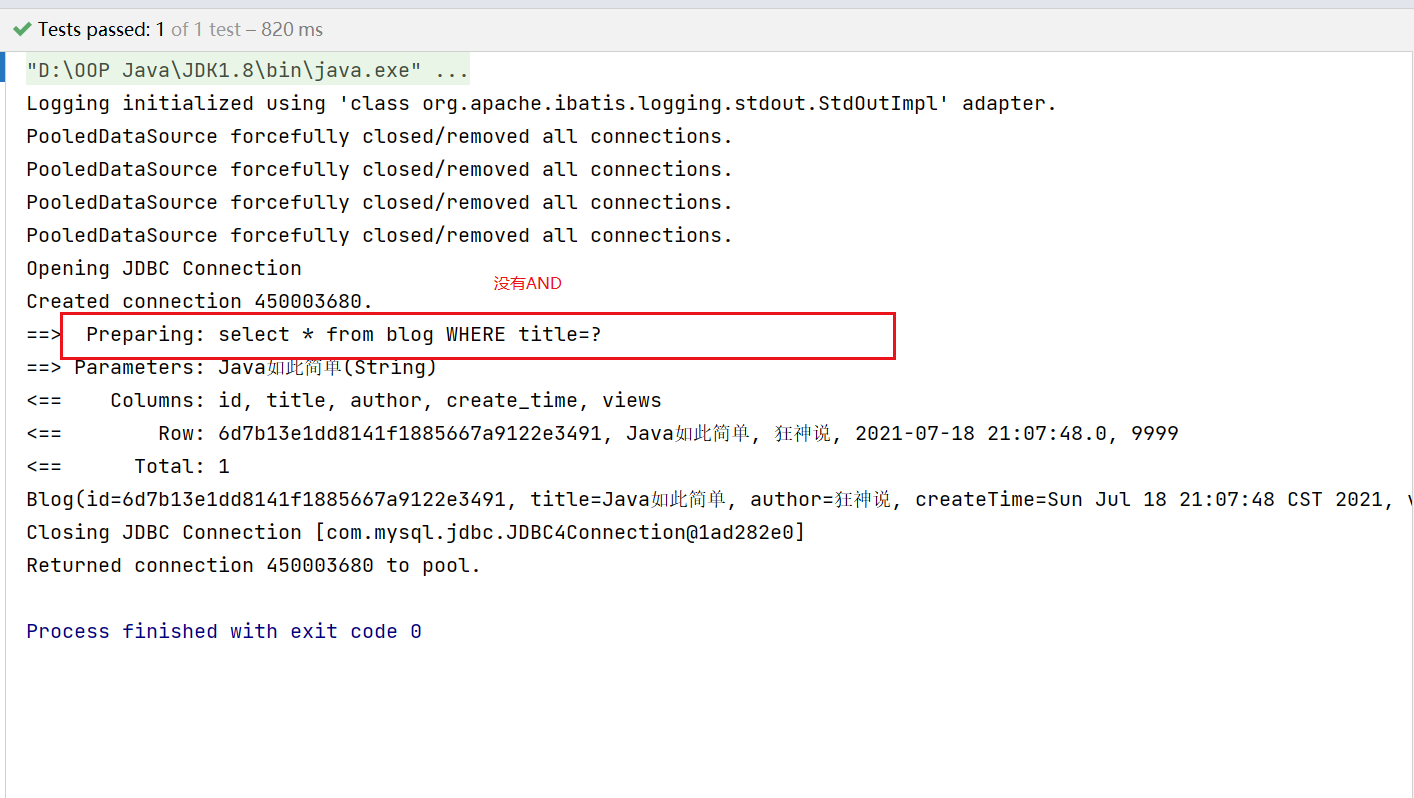
- trim标签
如果 where 元素与你期望的不太一样,你也可以通过自定义 trim 元素来定制 where 元素的功能。比如,和 where 元素等价的自定义 trim 元素为:
<trim prefix="WHERE" prefixOverrides="AND |OR ">
...
</trim>
prefixOverrides 属性会忽略通过管道符分隔的文本序列(注意此例中的空格是必要的)。上述例子会移除所有 prefixOverrides 属性中指定的内容,并且插入 prefix 属性中指定的内容。
- set标签
用于动态更新语句的类似解决方案叫做 set。set 元素可以用于动态包含需要更新的列,忽略其它不更新的列。
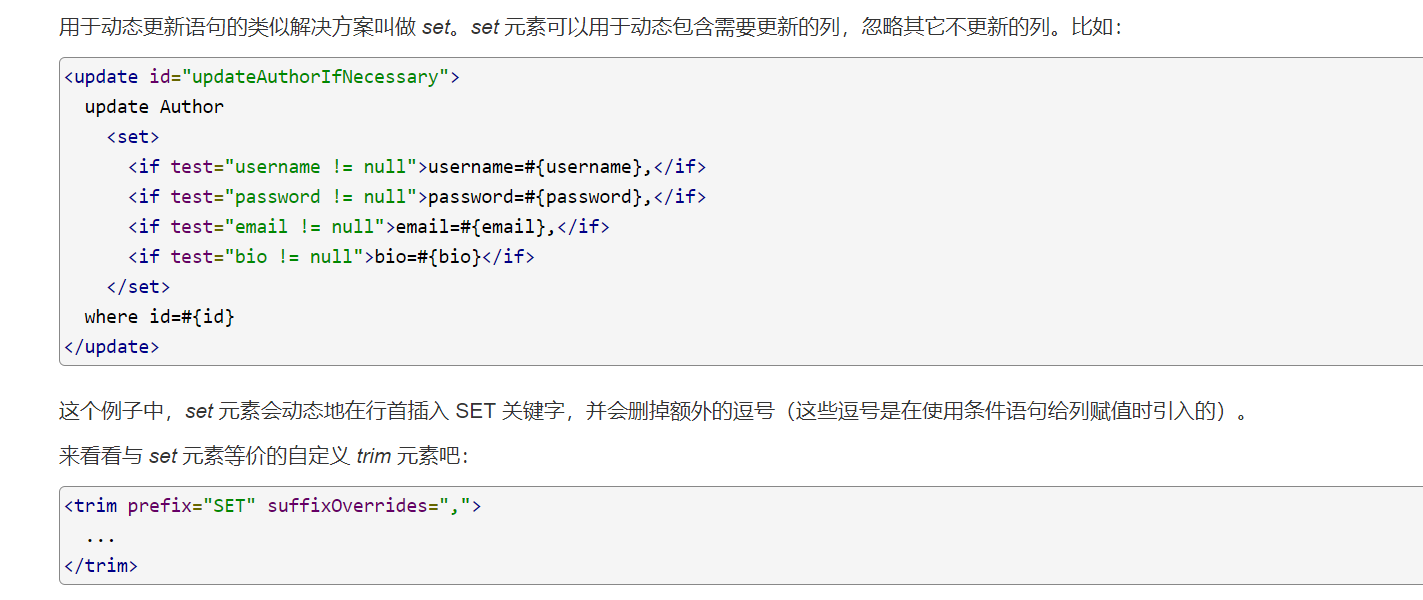
<update id="updateBlog" parameterType="map">
update blog
<set>
<if test="title != null">
title=#{title},
</if>
<if test="author !=null">
author=#{author}
</if>
</set>
where id=#{id}
</update>
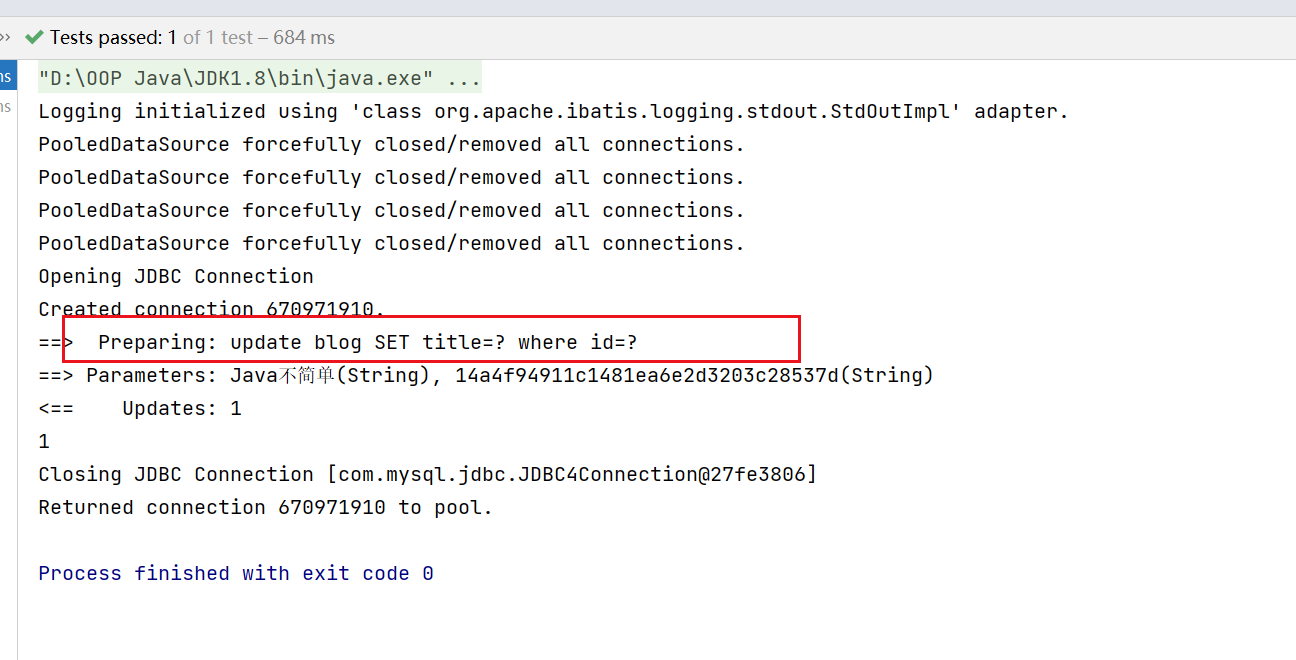
9.4、choose (when, otherwise)标签
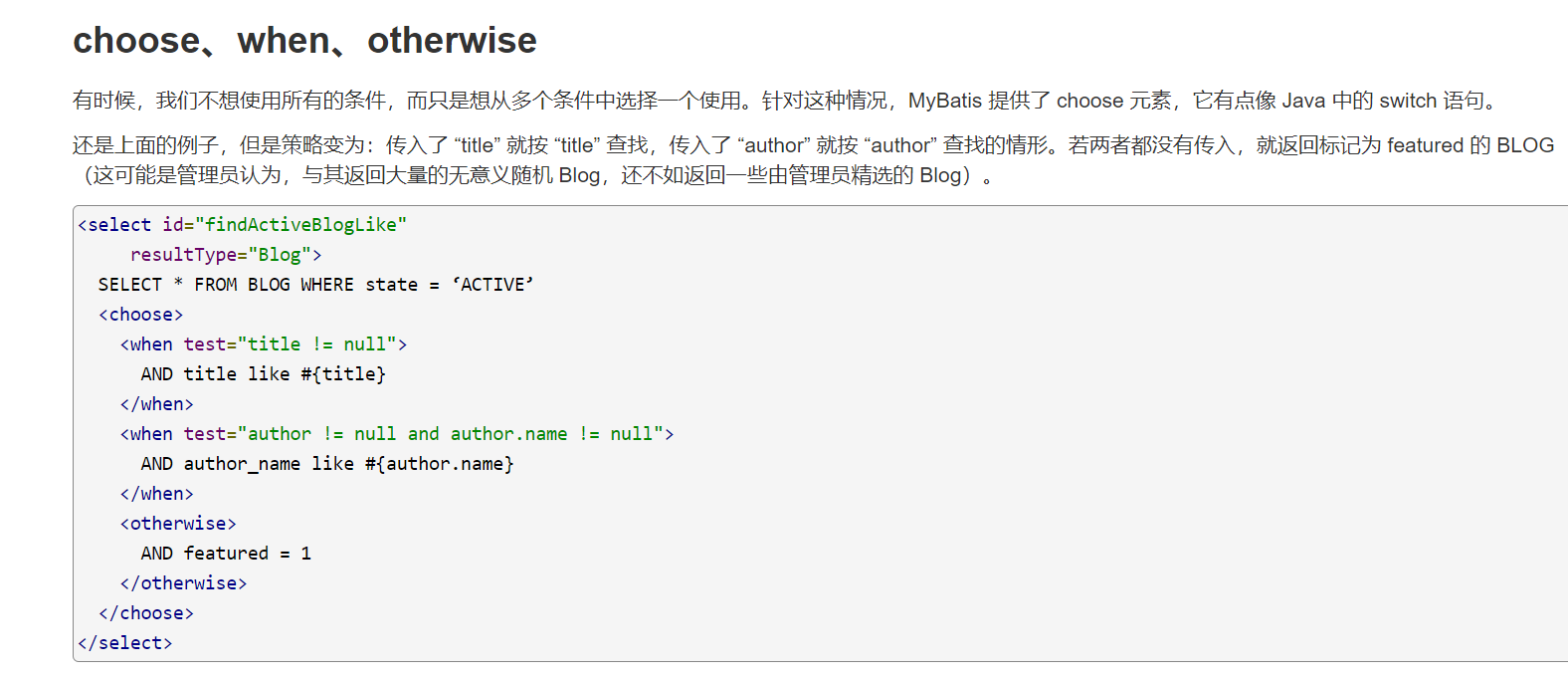
choose像Java 中的 switch 语句,只会匹配其中一个值
<select id="queryBlogChoose" parameterType="map" resultType="blog">
select * from blog
<where>
<choose>
<when test="title != null">
title=#{title}
</when>
<when test="author !=null">
and author=#{author}
</when>
<otherwise>
views = #{views}
</otherwise>
</choose>
</where>
</select>
9.5、SQL片段
有些时候我们可能将公共(重复) 的SQL抽取出来,方便复用,这就是<SQL>标签。
- 使用与注意点
- 使用
<SQL>抽取公共的部分 - 在需要使用的地方
<include> - 最好基于单表来定义重用的片段
- 不要存在
<where>标签
- 修改XML文件
<sql id="if-author-title">
<if test="author != null">author=#{author} </if>
<if test="title != null"> and title=#{title}</if>
</sql>
<!--查询-->
<!--如果上面的when都没有匹配成功 则匹配otherwise标签内-->
<select id="getBlog" parameterType="map" resultType="blog">
select * from blog
<where>
<include refid="if-author-title"/>
</where>
</select>
9.6、foreach标签
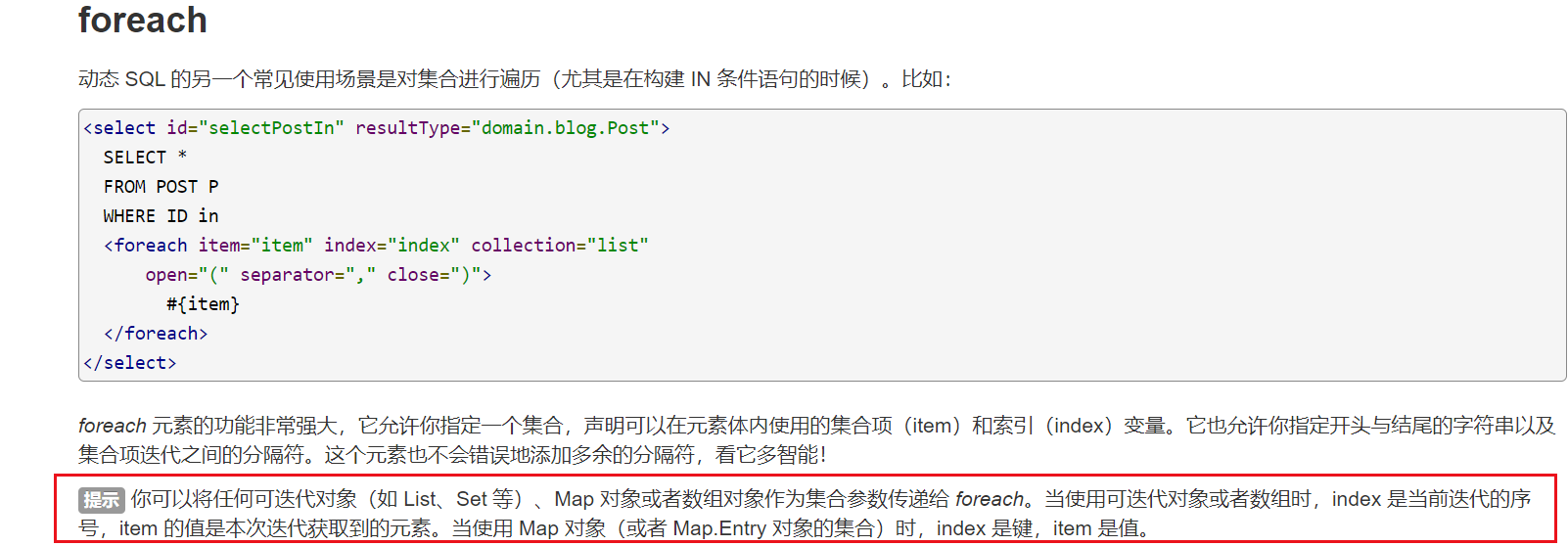
- 编辑接口
//查询用户id为1,2,3的用户
public List<Blog> getBlog(Map map);

- 编辑XML文件
<!--查询用户id为1,2,3的用户-->
<!--我们现在传入的是一个万能的map,这个map中可以存在一个集合-->
<select id="getBlog" parameterType="map" resultType="blog">
select * from blog
<where>
id in
<foreach collection="ids" item="userId" index="index" open="(" separator="," close=")">
#{userId}
</foreach>
</where>
</select>
- 编写测试类
@Test
public void test2(){
SqlSession session = MybatisUtils.getSqlSession();
BlogMapper mapper = session.getMapper(BlogMapper.class);
Map<String, List> map = new HashMap();
//准备list集合
ArrayList<Integer> ids = new ArrayList<Integer>();
ids.add(1);
ids.add(2);
ids.add(3);
map.put("ids",ids);
List<Blog> blog = mapper.getBlog(map);
for (Blog blog1 : blog) {
System.out.println(blog1);
}
session.close();
}
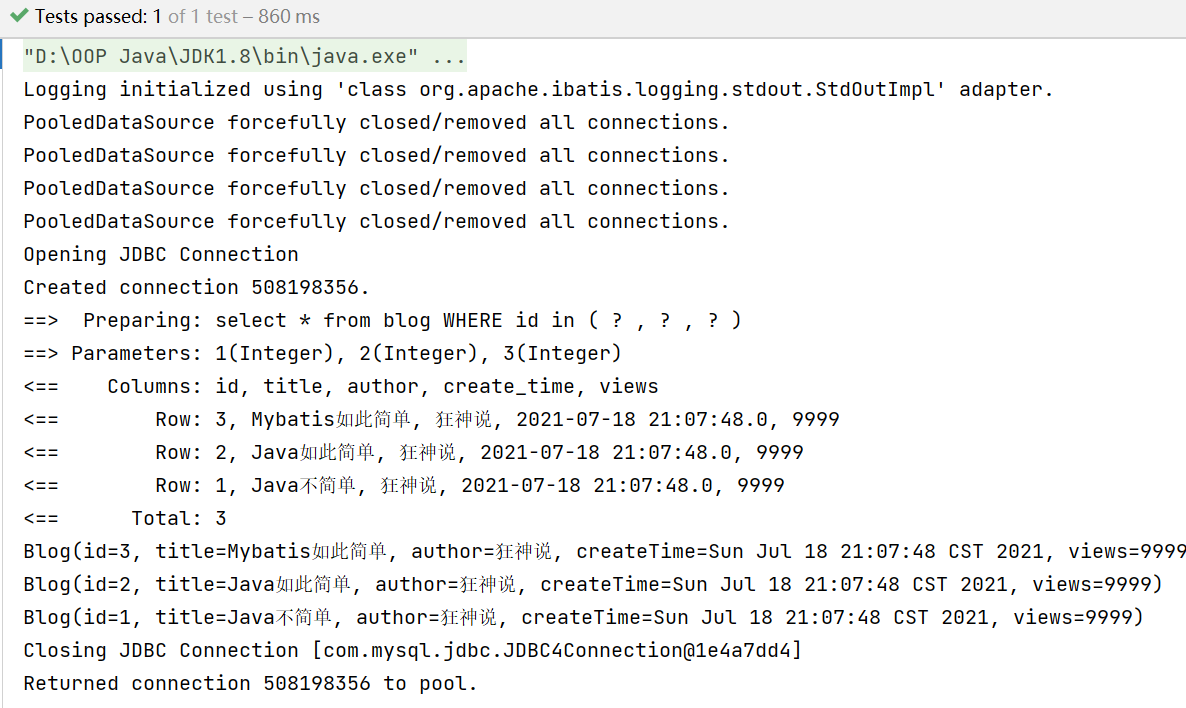
动态sql就是在拼接sql语句,我们只要保证sql的正确性,按照sql的格式,去排列组合就好了。
10、缓存
10.1、简介
查询:连接数据库,耗费资源!
一次查询结果,给他暂时存在一个可以直接取到的地方! --> 内存 :缓存
再次查询时就直接从缓存中取到数据就可了
- 什么是缓存[ Cache ]?
-
存在内存中的临时数据。
-
将用户经常查询的数据放在缓存(内存)中,用户去查询数据就不用从磁盘上(关系型数据库数据文件)查询,从缓存中查询,从而提高查询效率,解决了高并发系统的性能问题。
-
为什么使用缓存?
减少和数据库的交互次数,减少系统开销,提高系统效率。
-
什么样的数据能使用缓存?
经常查询并且不经常改变的数据。
10.2、Mybatis缓存
-
MyBatis包含一个非常强大的查询缓存特性,它可以非常方便地定制和配置缓存。缓存可以极大的提升查询效率。
-
MyBatis系统中默认定义了两级缓存:一级缓存和二级缓存。
-
默认情况下,只有一级缓存开启。(SqlSession级别的缓存,也称为本地缓存)。二级缓存需要手动开启和配置,他是基于 namespace 级别的缓存。
-
为了提高扩展性,MyBatis定义了缓存接口Cache,我们可以通过实现Cache接口来自定义二级缓存。
-
缓存清除策略

10.3、一级缓存
-
一级缓存也叫本地缓存(sqlSession)
-
与数据库同一次会话期间查询到的数据会放在本地缓存中
-
以后如果需要获取相同的数据,直接从缓存中拿,没必须再去查询数据库
- 测试
- 创建实体类
package com.liuxiang.pojo;
import lombok.Data;
@Data
public class User {
private int id;
private String name;
private String pwd;
}
- 编写接口
package com.liuxiang.dao;
import com.liuxiang.pojo.User;
import org.apache.ibatis.annotations.Param;
public interface UserMapper {
// 根据id查询用户
User queryUsers(@Param("id") int id);
}
- 编写xml
<?xml version="1.0" encoding="UTF8" ?>
<!DOCTYPE mapper
PUBLIC "-//mybatis.org//DTD Config 3.0//EN"
"http://mybatis.org/dtd/mybatis-3-mapper.dtd">
<mapper namespace="com.liuxiang.dao.UserMapper">
<select id="queryUsers" resultType="user">
select * from user where id = #{id}
</select>
</mapper>
- 编写测试代码
@Test
public void Test(){
SqlSession sqlSession = MybatisUtils.getSqlSession();
UserMapper mapper = sqlSession.getMapper(UserMapper.class);
User user = mapper.queryUsers(1);
System.out.println(user);
System.out.println("==========================");
User user2 = mapper.queryUsers(1);
System.out.println(user2);
System.out.println(user==user2);
sqlSession.close();
}
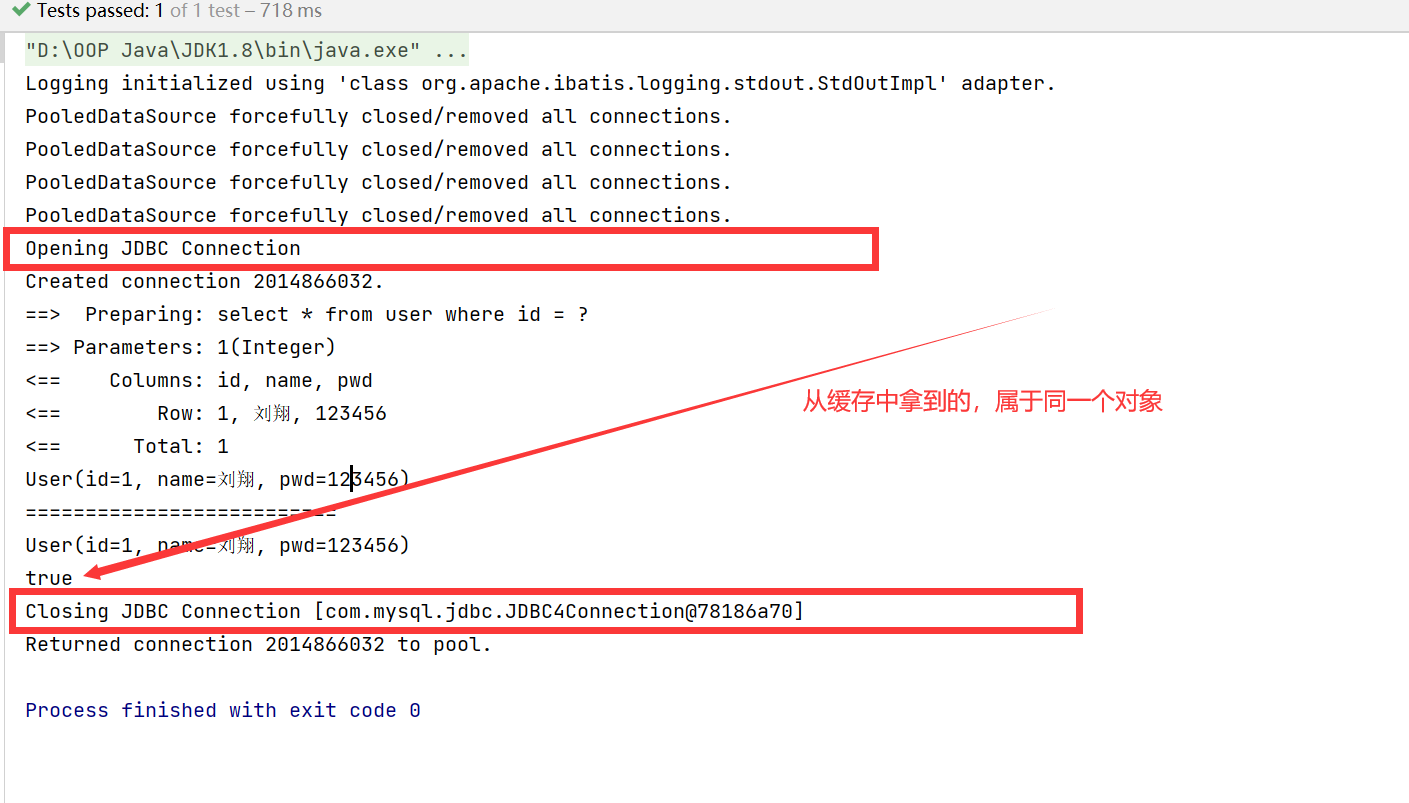
- 缓存失效的情况
- 查询不同的数据
- 增删改完要刷新缓存(可能会更改原来的数据,所以会刷新缓存)
- 手动清除缓存
sqlSession.clearCache(); // 手动清楚缓存 - 查询不同的 Mapper.xml
一级缓存默认开启,只在一次 sqlSession 会话中有效,也就是拿到连接到关闭连接这个区间段。
10.4、二级缓存
-
二级缓存也叫全局缓存,一级缓存作用域太低了,所以诞生了二级缓存
-
基于namespace级别的缓存,一个名称空间,对应一个二级缓存
-
工作机制
- 一个会话查询一条数据,这个数据就会被放在当前会话的一级缓存中
- 如果当前会话关闭了,这个会话对应的一级缓存就没了,但是我们想要的是,会话关闭了,一级缓存中的数据被保存到二级缓存中
- 新的会话查询信息,就可以从二级缓存中获取内容
- 不同的mapper查出的数据会放在自己对应的缓存(map)中
-
二级缓存是默认关闭的需要手动开启二级缓存
-
二级缓存生效机制:一级缓存 sqlSession1 关闭的时候会将数据放进二级缓存中,sqlSession2 使用的时候会去二级缓存中取
-
使用步骤
- 在
mybatis-config.xml中开启全局缓存
<!--开启缓存-->
<setting name="cacheEnabled" value="true"/>
- 在要使用二级缓存的
Mapper.xml映射文件中设置,可以自定义参数
<cache/>
<!--创建了一个 FIFO 缓存 每隔 60 秒刷新 最多可以存储结果对象或列表的 512 个引用 而且返回的对象被认为是只读的-->
<cache
eviction="FIFO"
flushInterval="60000"
size="512"
readOnly="true"/>
- 在
Mapper.xml映射文件中设置可以为不需要使用缓存的方法单独设定

- 排错
报错:Cause: java.io.NotSerializableException: com.liuxiang.pojo.User
解决方法:我们需要将实体类序列化,即实现 Serializable 接口。
@Data
public class User implements Serializable {
private int id;
private String name;
private String pwd;
}
- 测试
@Test
public void Test(){
SqlSession sqlSession1 = MybatisUtils.getSqlSession();
SqlSession sqlSession2 = MybatisUtils.getSqlSession();
UserMapper mapper1 = sqlSession1.getMapper(UserMapper.class);
User user1 = mapper1.queryUsers(1);
System.out.println(user1);
sqlSession1.close();
System.out.println("==========================");
UserMapper mapper2 = sqlSession2.getMapper(UserMapper.class);
User user2 = mapper2.queryUsers(1);
System.out.println(user2);
System.out.println(user1==user2);
sqlSession2.close();
}
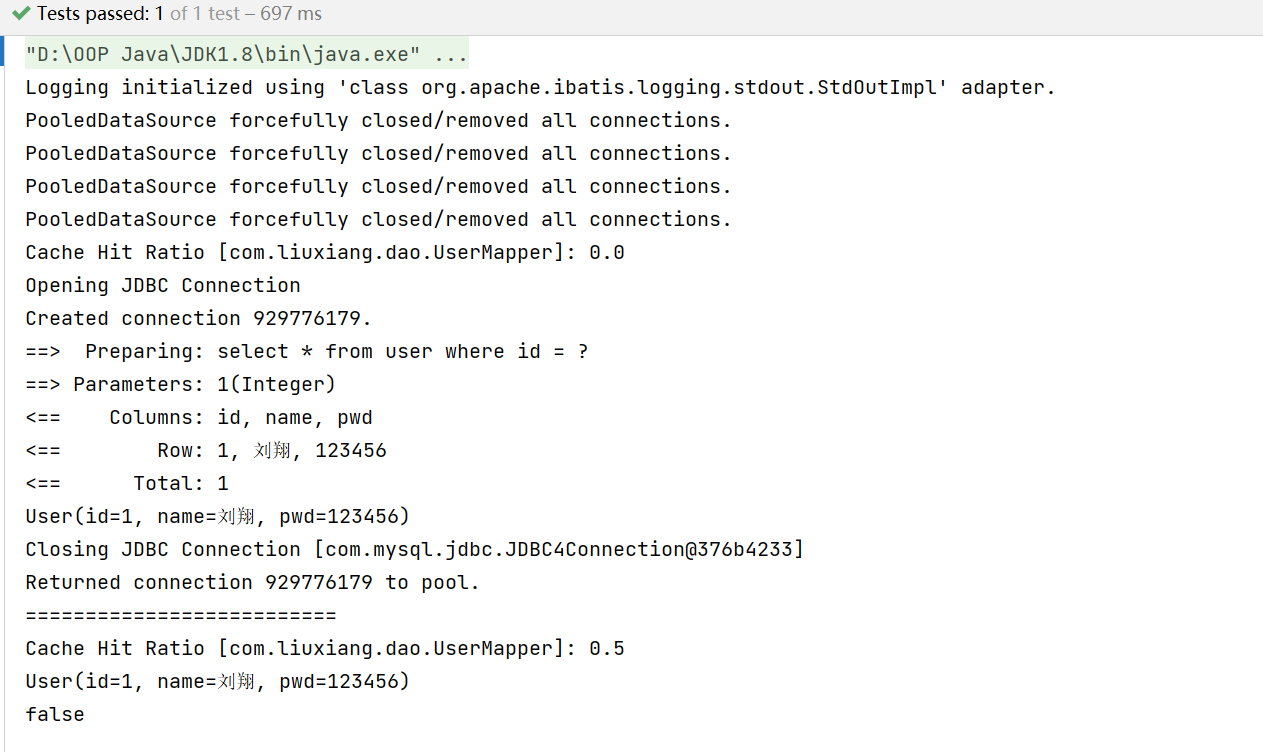
- 小结
- 只要开启了二级缓存,在同一个Mapper下都有效
- 所有的数据都会放在一级缓存
- 只有当会话提交的时间,或者关闭的时候才会提交到二级缓存中
10.5、缓存原理
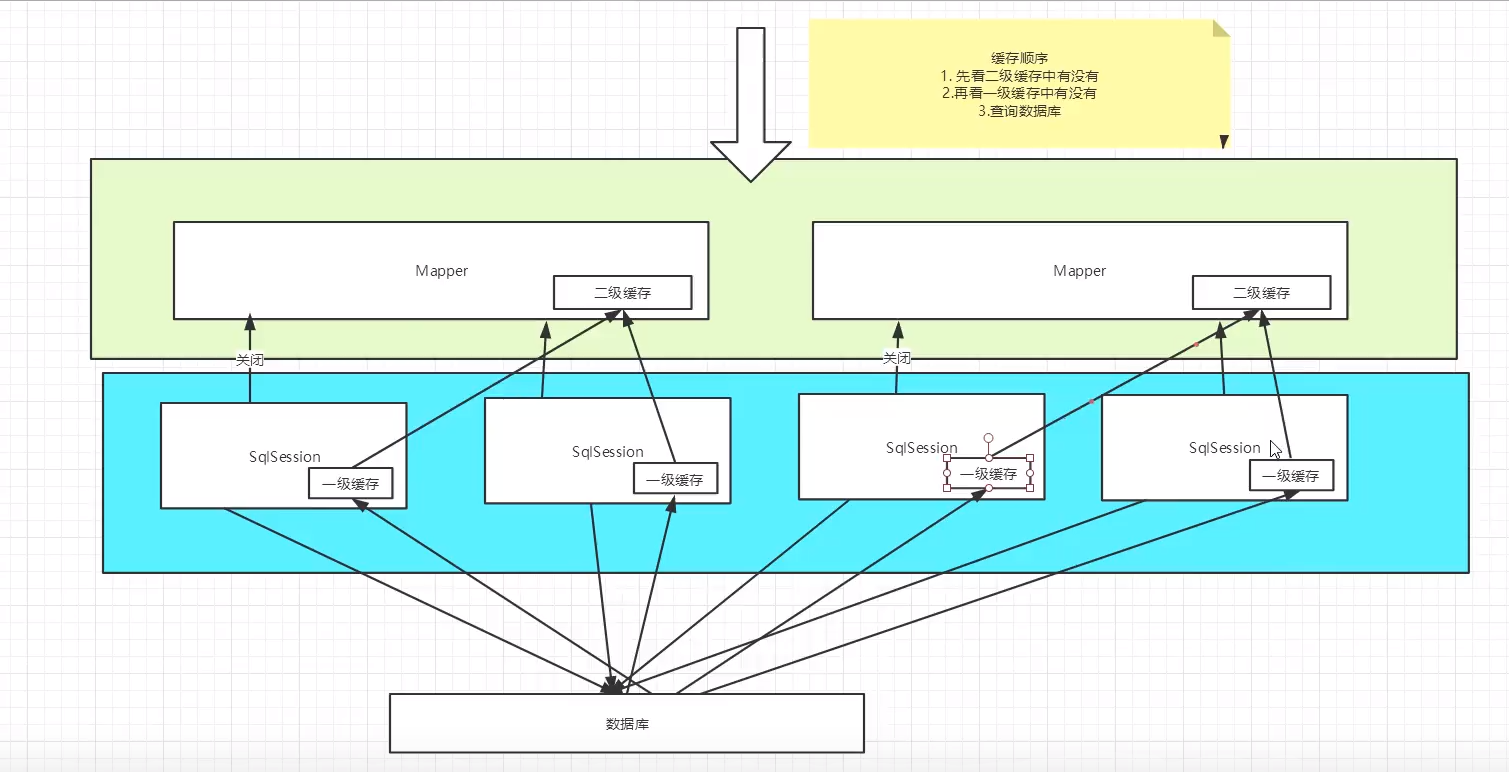
- 缓存顺序
- 先看二级缓存有没有数据
- 再看一级缓存中有没有数据
- 最后查询数据库
10.6、自定义缓存-ehCache
-
Ehcache 是一种广泛使用的 java分布式缓存,用于通用缓存
-
要在应用程序中使用Ehcache,需要引入依赖的jar包
- 导入Maven依赖
<!-- https://mvnrepository.com/artifact/org.mybatis.caches/mybatis-ehcache -->
<dependency>
<groupId>org.mybatis.caches</groupId>
<artifactId>mybatis-ehcache</artifactId>
<version>1.1.0</version>
</dependency>
- 在
mapper.xml中使用对应的缓存
<!--引入自定义缓存-->
<cache type="org.mybatis.caches.ehcache.EhcacheCache"/>
- 创建
ehcache.xml配置文件,里面提供一些自定义配置
<?xml version="1.0" encoding="UTF-8"?>
<ehcache xmlns:xsi="http://www.w3.org/2001/XMLSchema-instance"
xsi:noNamespaceSchemaLocation="http://ehcache.org/ehcache.xsd"
updateCheck="false">
<!--
diskStore:为缓存路径,ehcache分为内存和磁盘两级,此属性定义磁盘的缓存位置。参数解释如下:
user.home – 用户主目录
user.dir – 用户当前工作目录
java.io.tmpdir – 默认临时文件路径
-->
<diskStore path="./tmpdir/Tmp_EhCache"/>
<defaultCache
eternal="false"
maxElementsInMemory="10000"
overflowToDisk="false"
diskPersistent="false"
timeToIdleSeconds="1800"
timeToLiveSeconds="259200"
memoryStoreEvictionPolicy="LRU"/>
<cache
name="cloud_user"
eternal="false"
maxElementsInMemory="5000"
overflowToDisk="false"
diskPersistent="false"
timeToIdleSeconds="1800"
timeToLiveSeconds="1800"
memoryStoreEvictionPolicy="LRU"/>
<!--
defaultCache:默认缓存策略,当ehcache找不到定义的缓存时,则使用这个缓存策略。只能定义一个。
-->
<!--
name:缓存名称。
maxElementsInMemory:缓存最大数目
maxElementsOnDisk:硬盘最大缓存个数。
eternal:对象是否永久有效,一但设置了,timeout将不起作用。
overflowToDisk:是否保存到磁盘,当系统当机时
timeToIdleSeconds:设置对象在失效前的允许闲置时间(单位:秒)。仅当eternal=false对象不是永久有效时使用,可选属性,默认值是0,也就是可闲置时间无穷大。
timeToLiveSeconds:设置对象在失效前允许存活时间(单位:秒)。最大时间介于创建时间和失效时间之间。仅当eternal=false对象不是永久有效时使用,默认是0.,也就是对象存活时间无穷大。
diskPersistent:是否缓存虚拟机重启期数据 Whether the disk store persists between restarts of the Virtual Machine. The default value is false.
diskSpoolBufferSizeMB:这个参数设置DiskStore(磁盘缓存)的缓存区大小。默认是30MB。每个Cache都应该有自己的一个缓冲区。
diskExpiryThreadIntervalSeconds:磁盘失效线程运行时间间隔,默认是120秒。
memoryStoreEvictionPolicy:当达到maxElementsInMemory限制时,Ehcache将会根据指定的策略去清理内存。默认策略是LRU(最近最少使用)。你可以设置为FIFO(先进先出)或是LFU(较少使用)。
clearOnFlush:内存数量最大时是否清除。
memoryStoreEvictionPolicy:可选策略有:LRU(最近最少使用,默认策略)、FIFO(先进先出)、LFU(最少访问次数)。
FIFO,first in first out,这个是大家最熟的,先进先出。
LFU, Less Frequently Used,就是上面例子中使用的策略,直白一点就是讲一直以来最少被使用的。如上面所讲,缓存的元素有一个hit属性,hit值最小的将会被清出缓存。
LRU,Least Recently Used,最近最少使用的,缓存的元素有一个时间戳,当缓存容量满了,而又需要腾出地方来缓存新的元素的时候,那么现有缓存元素中时间戳离当前时间最远的元素将被清出缓存。
-->
</ehcache>

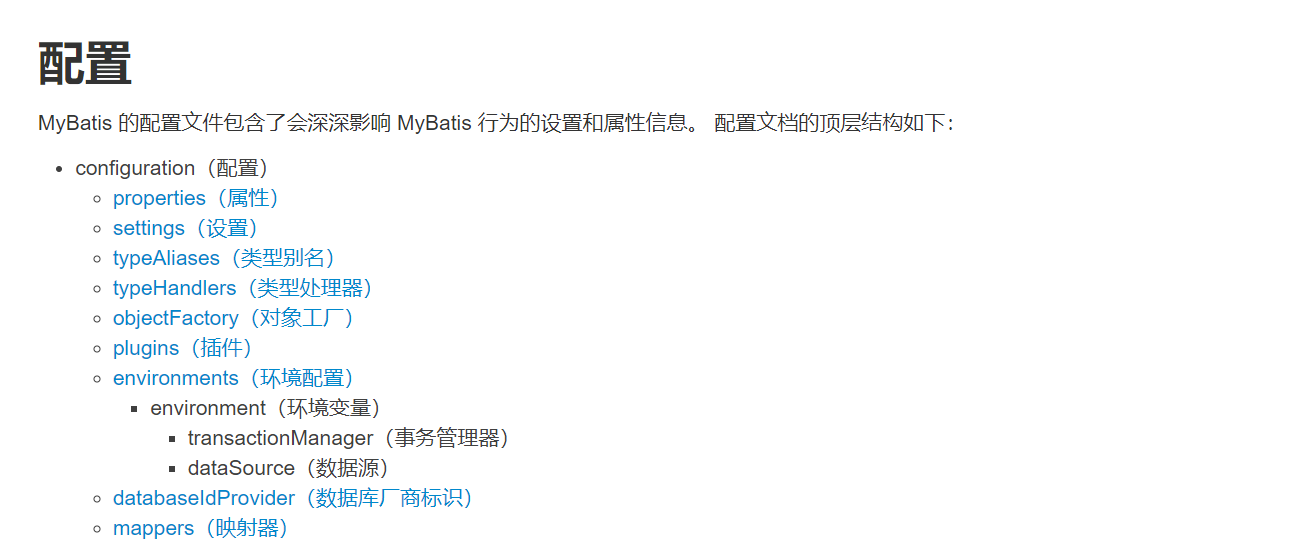


 浙公网安备 33010602011771号
浙公网安备 33010602011771号